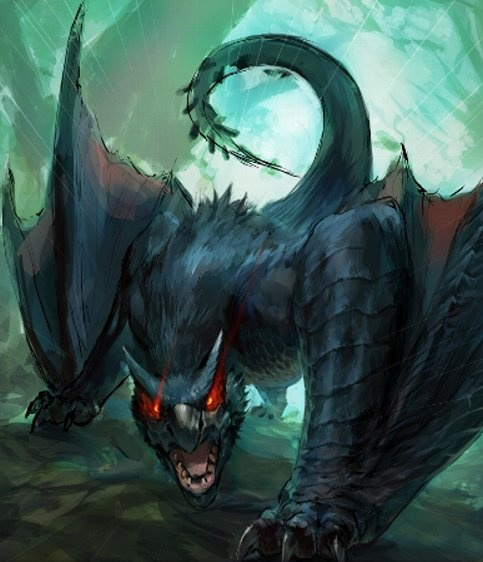
Table of Contents
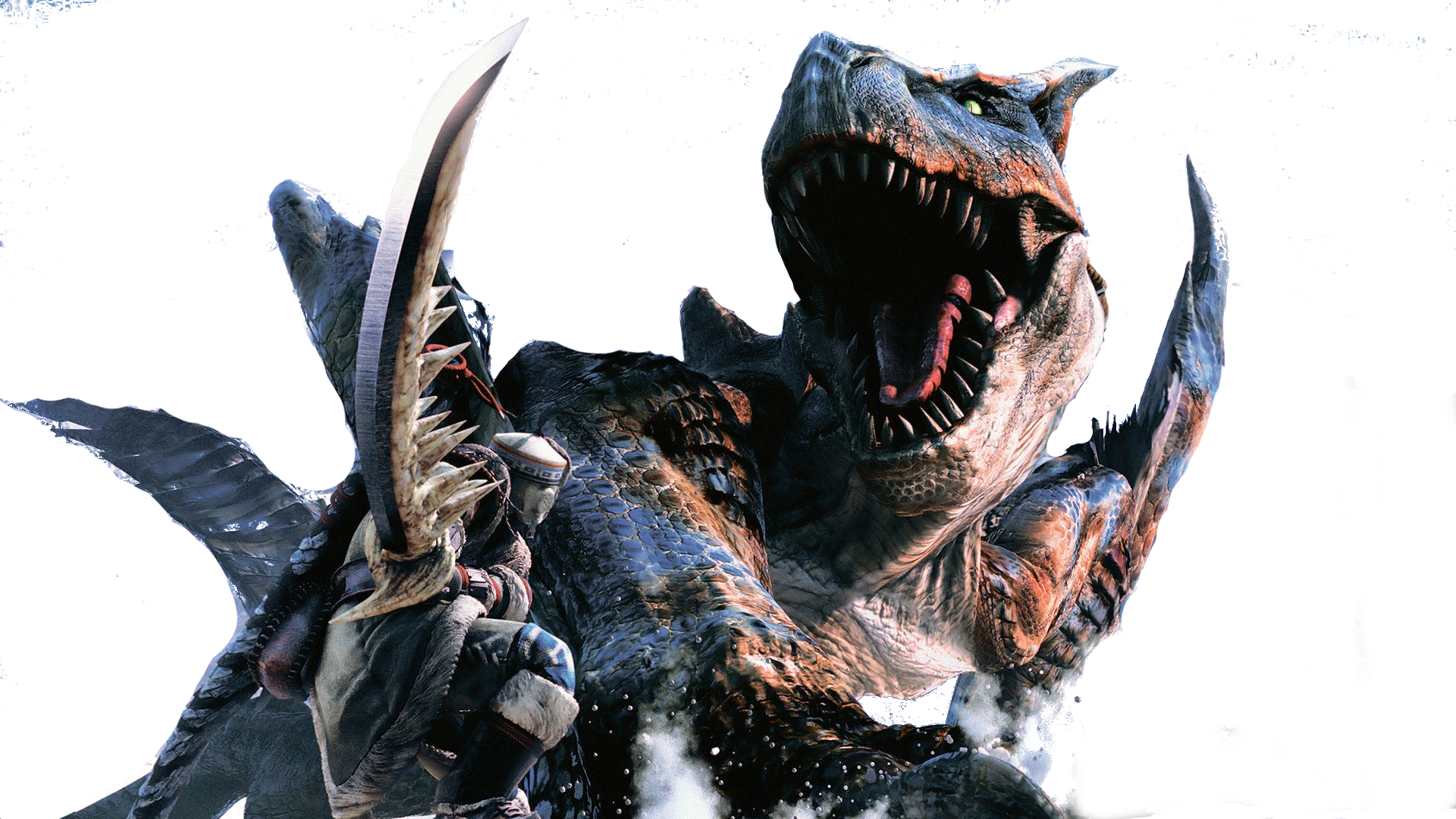
Flying Wyverns
Flying Wyverns are typically large, bipedal monsters capable of flight, having developed wings. Some, due to their sheer size and weight are able to hover in the air for a brief time. that have two wings. These Wyverns are known as "True Wyverns". However, there are some Wyverns that are quadrupedal, operating their wingarms as forearms instead like Tigrex and Nargacuga. These monsters have been dubbed by academics as "Pseudo Wyverns" (Pseudo meaning "False" or "Mimic"), due to these species only displaying partial Wyvern traits. Some are flightless despite their classification as Flying Wyverns, like the Akantor and Ukanlos. These wyverns show their Wyvern ancestry by the small forewings on their two front limbs. Flying wyverns have evolved over time and live in nearly every known area, encompassing many elements and types.
Giggi
The larvae form of Gigginox, Giggi are a Flying Wyvern related to the Khezu. Spawning from large, organic globules (Giggi Sacs) in dark caves, they exhibit unique behavior. When the torch is drawn, they retreat in fear; however, when the torch is extinguished, they slowly follow adventurers and latch onto them, constantly draining "blood". and must be "shaken" off.
Giggi are very low in the food chain while their still young. Giggi feed on the blood of other large species in order to survive but are preyed upon by some smaller predators. In the Tundra, they are hunted by Baggi packs. However, when a Giggi fully matures into a Gigginox, the tables are turned, and the hunters soon become the hunted. When they make it to a certain size, they will cocoon themselves by using a thread from their mouth to make a cocoon. These cocoons can rarely be seen in caves.
Giggi aren't very aggressive though are quite gluttonous. Once they see a potential prey item, they'll chase it down and attempt to attach themselves to the creature.
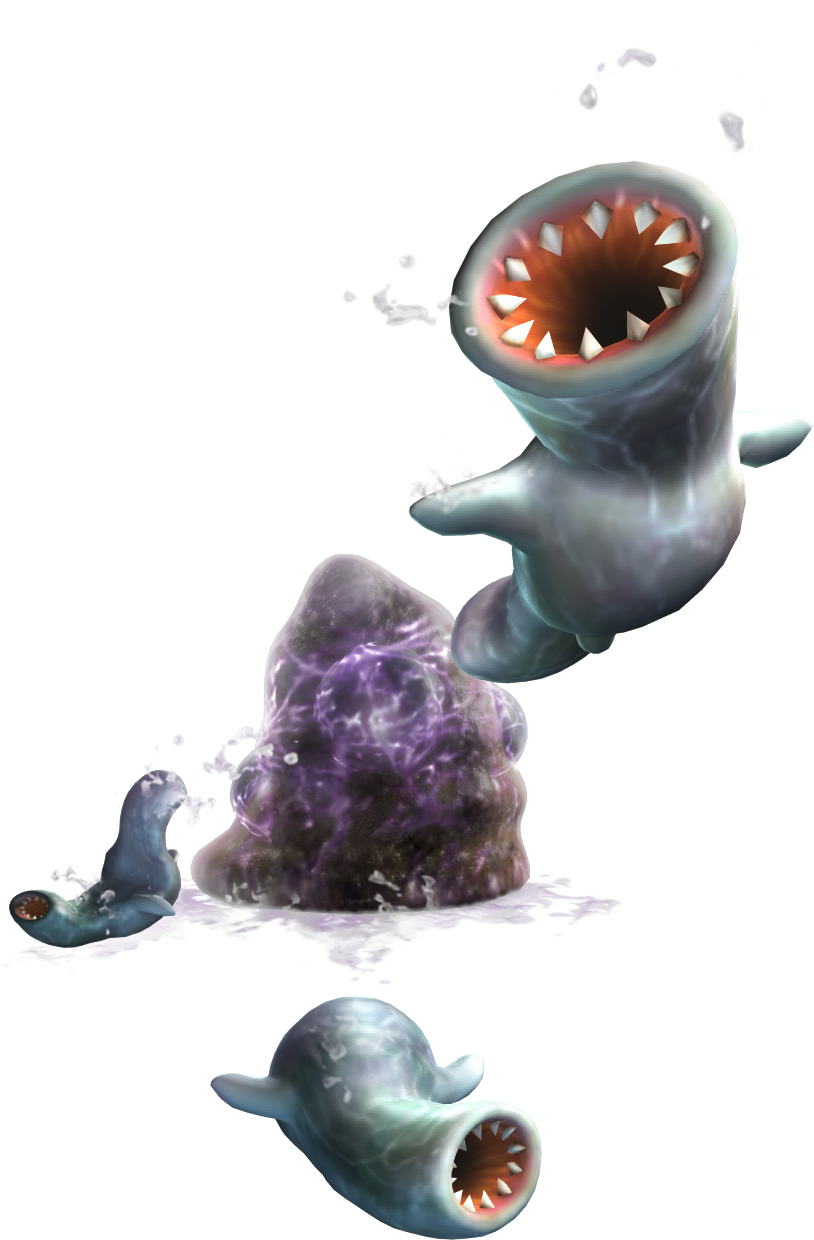
Giggi
Tiny wyvern (flying), unaligned
- Armor Class 8 (natural armor)
- Hit Points 51 (6d8+18)
- Speed 20 ft.
STR DEX CON INT WIS CHA 12 (+1) 6 (-2) 16 (+3) 3 (+4) 6 (-2) 2 (+4)
- Skills Stealth +0
- Damage Vulnerabilities fire
- Senses blindsight 60 Ft., passive Perception 8
- Languages -
- Challenge 1/2 (100 xp)
Leech. If a giggi hit with a bite attack, it can then use its bonus action to attach itself to a creature (escape DC 10). At the start of the giggi's turn it deal 5 (2d4) necrotic damage and regains hit points equal to that amount.
Actions
Bite. Melee Weapon Attack. +3 to hit, reach 5 ft., one target. Hit 4 (1d6 + 1) piercing damage plus 2 (1d4) necrotic damage. The target's hit point maximum is reduced by an amount equal to the necrotic damage taken, and the giggi regains hit points equal to that amount. The reduction lasts until the target finishes a long rest. The target dies if this effect reduces its hit point maximum to 0.
Poison Spit. Range Weapon Attack. +3 to hit, range 30/60 ft., one target. Hit 3 (1d6) poison damage.
Gigginox
The Gigginox is a Flying Wyvern that is the adult form of the Giggi. Gigginox's closest relative is Khezu. They are blind, cave-dwelling Wyverns. However, they do not sense prey by smell; instead, Gigginox have a special organ that can detect the body heat of their prey.
Gigginox are wide and flat, unlike the Khezu, which is bulky and has large fat reserves. Also, Gigginox does not have highly moisturized skin, and unlike the Khezu, it does not have visible veins. Gigginox is notably much more agile than the Khezu, being able to flip around without difficulty, and being much faster, probably due to their flat body, and their ability to sense body-heat instead of smelling. While the Khezu primarily uses its developed hind legs to leap around or to the ceilings of caves, Gigginox will use all four limbs plus its tail to propel itself, suggesting that the Gigginox's limbs aren't as well developed as the Khezu. Gigginox have a circular, leech-like maw, which contains many sharp teeth.
Also similar to the Khezu is the Gigginox's elastic neck and tail, which can stretch out to twice their length in an attempt to attack the hunter. Their top skin is grey-white, and their under-skin is dark red. Gigginox have a circular, leech-like maw, which contains many sharp teeth. They can spit poison or release it as a form of gas from pores under their body. Gigginox can lay gelatinous globs, called Giggi Sacs, that spawn young Giggi.
The Gigginox is highly territorial, staking out a cavern or other such area to lay its eggs. During the day, they sleep much longer than most other monsters in the area but at night they become truly active. They will spend some time awake during the day but if they instantly sense potential prey in the area, they will actively stalk the creature in the caves. Said prey items are later left behind as corpses in caves to make it easier to catch prey. Despite a Gigginox's looks, they are considered to be quite intelligent compared to some other Flying Wyverns. Gigginox even save food in their caves.
Gigginox
Large wyvern (flying), unaligned
- Armor Class 17 (natural armor)
- Hit Points 157 (15d10 + 75)
- Speed 30 ft., fly 20 ft., climb 30 ft.
STR DEX CON INT WIS CHA 19 (+4) 14 (+2) 21 (+5) 16 (+3) 13 (+1) 13 (+1)
- Skills Perception +5
- Damage Immunities poison
- Condition Immunities blind, charmed, poisoned
- Senses blindsight 60 ft., passive Perception 15
- Languages -
- Challenge 10 (5,900 xp)
Keen Sight. The gigginox has advantage on Wisdom (Perception) checks that rely on sight.
Standing Leap. The gigginox's long jump is up to 30 feet and its high jump is up to 15 feet, with or without a running start.
Actions
Multiattack. The gigginox makes four attacks, two bite attacks and two tail attacks.
Bite. Melee Weapon Attack: +8 to hit, reach 15 ft., one target. Hit 13 (2d8 + 4) piercing damage plus 7 (2d6) poison damage.
Tail. Melee Weapon Attack: +8 to hit, reach 15 ft., one target. Hit 13 (2d8 + 4) bludgeoning damage plus 7 (2d6) poison damage.
Poison Gas. (recharge 5-6). The gigginox releases a poisonous gas from its underside in a 10-foot radius around it. Each creatures in that area must make a DC 17 Constitution saving throw, taking 44 (8d10) poison damage and become poisoned for 1 minute. On a success the creature takes half damage is not poisoned.
Lay Eggs (3/day). The gigginox lays a gelatinous glob that spawns 2 (1d4) giggi at the start of its turn. The giggi's initiative is right after the gigginox. The egg sac can be attacked and destroyed (AC 12; hp 20; immunity to bludgeoning, poison, and psychic damage).
Reactions
Poisonous Retreat. After being hit by a melee attack, the gigginox can use its reaction to disengage by leaping backwards 15 feet and sprays poisonous spores at the attacker. The target must make a DC 17 Constitution saving throw or become poisoned until the end of their next turn.
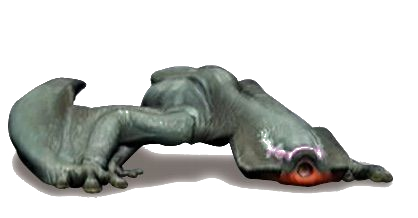
Basarios
Basarios is a smaller, rocky wyvern. It is the juvenile form of Gravios. It's hard, stone-like shell can be used for protection against other large wyverns, doubling up as effective camouflage when Basarios partially buries itself in the ground.
It is able to release either sleeping or poisonous gas from its underside and, on extremely rare occasions, a fire plume. Although it prefers to charge towards adversaries. When resting, it burrows underground, exposing only its back, giving it the appearance of a large gray rock. Being very heavy, it is a slow mover, and although it has wings, it rarely uses them to fly. Even when it does, its weight allows it to fly only for a short time.
Despite its ability to hide, in most areas it is visible. This is because the rocks on its back are a slightly lighter color than other rocks, or because it has burrowed into plain view in the middle of the area.
Variant Basarios
The basarios is known to have other type of effects besides sleep gas. A basarios may have a poisonous gas or on extremely rare cases it creates fire plume. The CR does not change when replacing the sleep gas with one of these effects:
- Poisonous Gas. The basarios releases a poisonous gas from its underside in a 15-foot radius around it. Each creature in that area must make a DC 15 Constitution saving throw or, become poisoned for 1 minute. A creature repeat the saving throw at the end of their turn, ending the effect on a success.
- Fire Plume. The basarios releases a plume of fire from its underside in a 15-foot radius around it. Each creature in that area must make a DC 15 Dexterity saving throw or, take 18 (5d6) fire damage on a failed save or half as much on a successful one.
Basarios
Huge wyvern (flying), unaligned
- Armor Class 18 (natural armor)
- Hit Points 136 (13d12 + 52)
- Speed 40 ft., burrow 30 ft.
STR DEX CON INT WIS CHA 24 (+7) 9 (-1) 19 (+4) 3 (-4) 11 (+0) 6 (-2)
- Damage Resistances fire
- Senses passive Perception 10
- Languages -
- Challenge 6 (2,300 xp)
Trampling Charge. If the basarios moves at least 20 feet straight toward a creature and then hits it with a Ram attack on the same turn , that target must succeed on a DC 18 Strength saving throw or be knocked prone. If the target is prone, the basarios can make one Body Slam attack against it as a bonus action.
Stone Camouflage. The basarios has advantage on Dexterity (Stealth) checks made to hide in rocky terrain while burrowed.
Actions
Body Slam. Melee Weapon Attack: +10 to hit, reach 5 ft., one target. Hit 29 (4d10 + 7) bludgeoning damage.
Ram. Melee Weapon Attack. +10 to hit, reach 5 ft., one target. Hit 25 (4d8 + 7) bludgeoning damage.
Sleep Gas. (recharge 5-6). The basarios releases a sleeping gas from its underside in a 15-foot radius around it. Each creature in that area must make a DC 15 Constitution saving throw or, they fall Unconscious until the spell ends, the sleeper takes damage, or someone uses an action to shake or slap the sleeper awake.
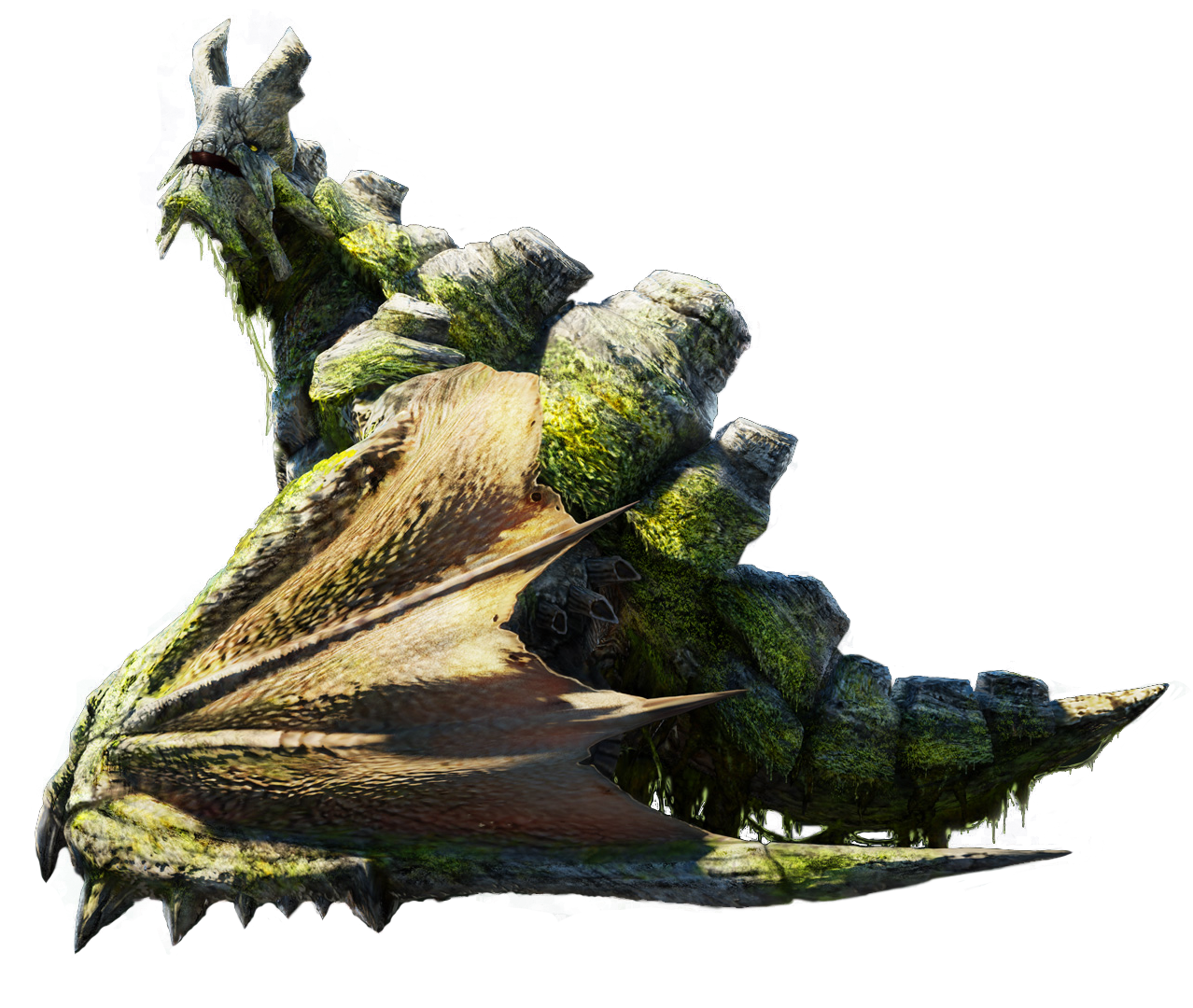
Gravios
Gravios is covered in a dense, stone-like armored shell which protects its body from physical damage. It is very large in size, towering over most other wyverns and measuring several dozen feet in length. Because of its size and incredible weight, it is only capable of limited flight, despite having large and seemingly-developed wings. It has a thick tail with a mace-like club at the end.
Gaps in the Gravios underside expel a knockout gas potent enough to put many monsters to sleep. It seems to have lost its poisoning ability. This gas is produced inside the Gravios body. Furthermore, these defense mechanisms may be used to deter would-be predators, although there would be few monsters able to penetrate the Gravios shell. Gravios can also expel flammable gas as a waste product of its 'heat beam', and of its diet.
Gravios is relatively docile until provoked. Like most wyverns, it is fiercely territorial. The Gravios inhabits large areas of the Volcano, where it is sufficiently large enough to incubate and raise its juvenile Basarios.
Gravios can be found in the Volcano and Swamp. It can easily withstand the heat of molten lava, and traverse it at will. Gravios eats rocks and minerals for nutrients.
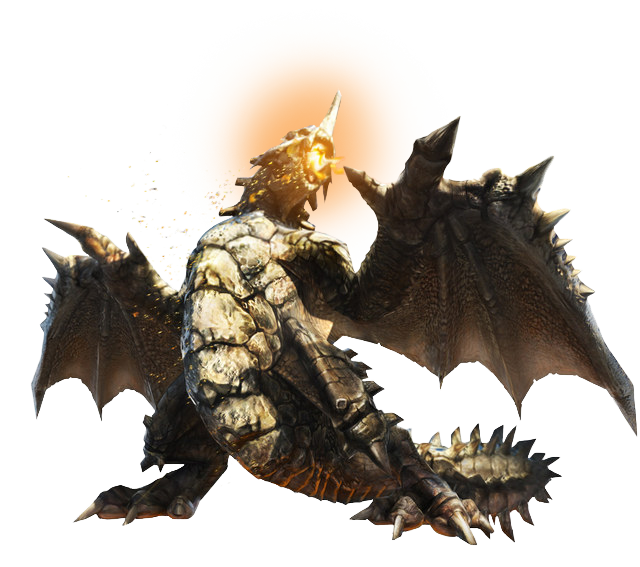
Gravios
Gargantuan wyvern (flying), unaligned
- Armor Class 22 (natural armor)
- Hit Points 175 (10d20 + 70)
- Speed 40 ft., burrow 30 ft.
STR DEX CON INT WIS CHA 26 (+8) 11 (+0) 24 (+7) 11 (0) 12 (+1) 9 (-1)
- Saving Throws Con +12, Wis +6
- Damage Immunities fire; piercing and slashing from nonmagical weapons
- Damage Resistances lightning, piercing, slashing; bludgeoning damage from nonmagical weapons
- Senses passive Perception 11
- Languages -
- Challenge 15 (13,000 xp)
Trampling Charge. If the gravios moves at least 20 feet straight toward a creature and then hits it with a Ram attack on the same turn , that target must succeed on a DC 21 Strength saving throw or be knocked prone. If the target is prone, the gravios can make one Body Slam attack against it as a bonus action.
Actions
Body Slam. Melee Weapon Attack: +13 to hit, reach 5 ft., one target. Hit 30 (4d10 + 8) bludgeoning damage.
Ram. Melee Weapon Attack. +13 to hit, reach 5 ft., one target. Hit 26 (4d8 + 8) bludgeoning damage.
Tail. Melee Weapon Attack. +13 to hit, reach 10 ft., one target. Hit 17 (2d8 + 8) bludgeoning damage.
Sleep Gas. (3/day). The gravios releases a sleeping gas from its underside. All creatures within 15 feet must make a DC 20 Constitution saving throw or, they fall Unconscious until the spell ends, the sleeper takes damage, or someone uses an action to shake or slap the sleeper awake.
Heat Beam (recharge 5-6). The gravios exhales fire in a 90-foot line that is 10 feet wide. Each creature in that line must make a DC 20 Dexterity saving throw, taking 35 (10d6) fire damage on a failed save, or half as much damage on a successful one.
Legendary Actions
The gravios can take 3 legendary actions, choosing from the options below. Only one legendary action option can be used at a time and only at the end of another creatures turn. The gravios regains spent legendary actions at the start of its turn.
Move. The gravios moves up to half its speed
Tail. The gravios makes a Tail attack.
Quake (Costs 2 Actions). The gravios flies 15 feet into the air and crashes into the ground violently shaking the earth. Each creature within 30 feet of the gravios must succeed on a DC 21 Strength saving throw or be knocked prone.
Seregios
Seregios are powerful, territorial and highly aggressive predators. With their razor sharp weapons a Seregios can make short work of their unfortunate victims. Larger Seregios have been seen flying with smaller Flying Wyverns clutched in their talons, including other Seregios. Reports like this confirm that the wyverns will cannibalize each other. Due to their capability of living in a number of different environments, Seregios compete with a large number of other large predators. Seregios have also been witnessed aggressively attacking Rathalos and Rathian (including their subspecies) and are said to be serious rivals toward them.
The Seregios is covered in extremely sharp Blade Scales. These scales are capable of cutting through the armor of certain prey and flinging them at a distance with good aim. On impact the scales will embed themselves in the victim like shrapnel and can leave complicated gouges in prey and even rocks. The wounds the scales leave behind are extremely painful for the victim and said pain can last for long periods of time, possibly causing infections as well. The most defining trait that this species is that they have Zygodactyly feet like roadrunners and other birds. Seregios are the only species in the Flying Wyvern class that possess them. The feet of these creatures can be used as devastating weapons against prey and enemies alike. A hunting Seregios use their feet to grasp their prey in a vice-like grip giving their victims little hope for escape. When in flight the claws on their wings are utilized for control and to allow them to shift their weight more easily. A Seregios is one of a few wyverns whose flight mobility and control is comparable to a Rathalos. Seregios will also utilize the thick, sturdy blade-like horns on their heads along with their blade-scaled covered tails in combat.
Seregios are hostile usurpers of the land. They are violent fighters and will battle other monsters in order to kick them out of their territory claim it as their own, this includes their own kind in their land. In most cases, the monster they are fighting will end up dead after the battle and while some live on. The bigger the Seregios, the larger amount of territory it needs. Once a territory is gained by a Seregios, it will mark its territory with its own Blade Scales.
Seregios
Large wyvern (flying), unaligned
- Armor Class 14 (natural armor)
- Hit Points 147 (16d10+48)
- Speed 40 ft., fly 80 ft.
STR DEX CON INT WIS CHA 19 (+4) 11 (+0) 16 (+3) 14 (+2) 12 (+1) 15 (+2)
- Saving Throws Dex +3, Wis +4, Cha +5
- Skills Acrobatics +3, Perception +4
- Senses darkvision 60 Ft., passive Perception 14
- Languages -
- Challenge 7 (2,900 xp)
Bladed Scales Regrowth. The seregios has forty-eight bladed scales. Used scales regrow when the seregios finishes a long rest.
Open Wound. When a creature is hit by the seregios attacks, it must succeed on a DC 14 Constitution saving throw or lose 2 (1d4) hit points at the start of each of its turns due to an open wound. Each time the seregios hits the wounded target with an attack, the damage dealt by the wound increases by 2 (1d4). Any creature can take an action to stanch the wound with a successful DC 12 Wisdom (Medicine) check. The wound also closes if the target receives magical healing.
Actions
Multiattack. The seregios makes three attacks: one with its tail and two with its talons or three with its bladed scales.
Talon. Melee Weapon Attack. +7 to hit, reach 5 ft., one target. Hit 11 (2d6 + 4) piercing damage. If the target is a creature, it is grappled (escape DC 15). Until this grapple ends, the target is restrained. The seregios can grapple one large creature, or two medium creatures at a time.
Tail. Melee Weapon Attack. +7 to hit, 10 ft., one target. Hit 13 (2d8 + 4) piercing damage.
Bladed Scales. Range Weapon Attack. +7 to hit, range 100/200 ft., one target. Hit 13 (2d8 + 4) piercing damage.
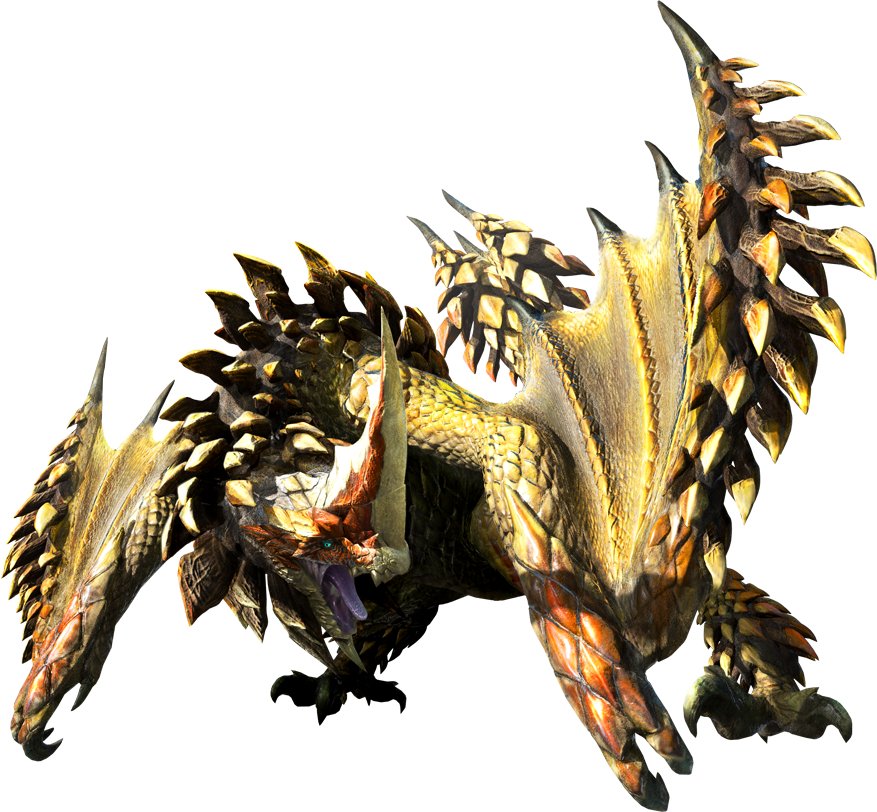
Paolumu
Paolumu is a bat-like wyvern that slightly resembles the Honduran white bat. Like said bat species, Paolumu is covered in white fur and has a pink face. Though it is covered in fur, Paolumu also has some brown scales covering its back, underbelly, and tail. The Paolumu has rodent-like buck teeth this is because its diet consists of the eggs that comes off the coral which it sucks in using its incredible breathing power.
Inside of Paolumu's neck is a special air sac that inflates once it has sucked in enough air. Once its air sac has inflated, Paolumu is able to float in the air like a balloon and able to attack foes from above. While floating, Paolumu will use its hardtail to batter foes at close range. Paolumu is also able to breathe wind at foes, it can also use its inhaling powers to draw in hunters closer or to make them stagger.
Paolumu are fairly calm unless provoked by a threat. Once provoked, they will become aggressive.
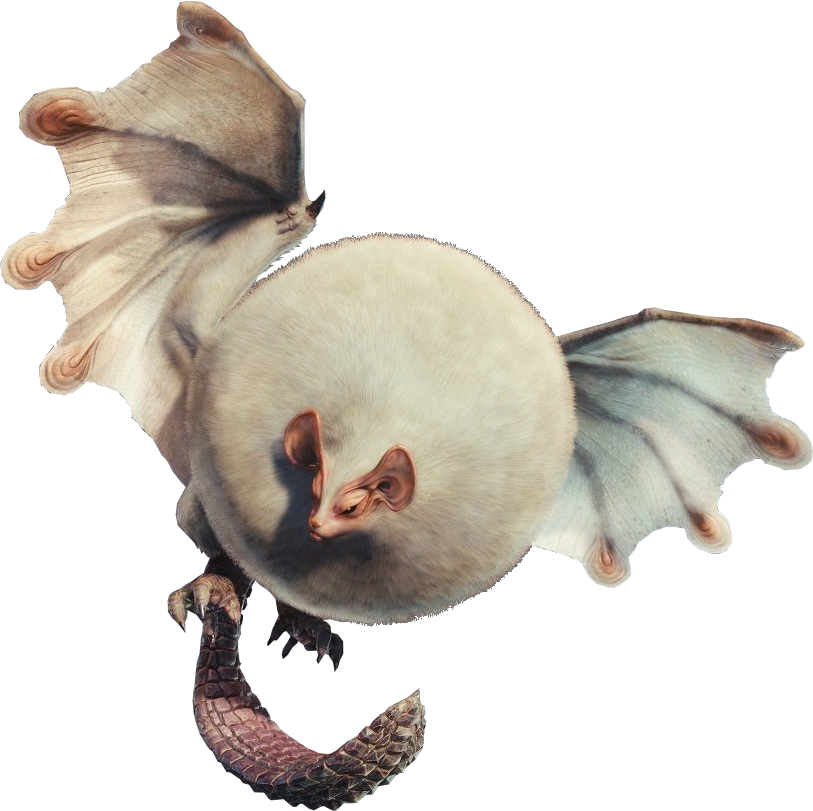
Paolumu
Large wyvern (flying), unaligned
- Armor Class 16 (natural armor)
- Hit Points 142 (15d10+60)
- Speed 30 ft., fly 60 ft.
STR DEX CON INT WIS CHA 18 (+4) 12 (+1) 18 (+4) 3 (-4) 10 (+0) 3 (-4)
- Skills Acrobatics +4
- Senses passive Perception 10
- Languages -
- Challenge 7 (2,900 xp)
Blind Panic. If the paolumu is flying and becomes blinded. It panicks, ending its enlarge and falls prone.
Actions
Multiattack. The paolumu makes two attacks: one with its bite and one with its tail.
Tail. Melee Weapon Attack. +7 to hit, reach 10 ft., one target. Hit: 15 (2d10 + 4) bludgeoning damage, or 20 (3d10 + 4) piercing damage while enlarged.
Bite. Melee Weapon Attack. +7 to hit, reach 5 ft., one target. Hit: 13 (2d8 + 4) piercing damage, or 17 (3d8 + 4) piercing damage while enlarged.
Enlarge (Recharges after a Short or Long Rest). For 1 minute, the paolumu magically increases in size, along with anything it is wearing or carrying. While enlarged, the paolumu is Huge, it can hover, roll one additional weapon damage die on Strength-based weapon attacks (included in the attacks), and makes Strength checks and Strength saving throws with advantage. If the paolumu lacks the room to become Large, it attains the maximum size possible in the space available.
Dive Bomb. If the paolumu is flying, enlarged and dives at least 10 feet straight toward a target it can then use this action to slam its body in a space that contains one or more other creatures. Each of those creatures must succeed on a DC 15 Strength or Dexterity saving throw (target's choice) or be knocked prone and take 31 (7d8) bludgeoning damage. On a successful save, the creature takes only half the damage, isn't knocked prone, and is pushed 5 feet out of the paolumu's space into an unoccupied space of the creature's choice. If no unoccupied space is with in range, the creature instead falls prone in the paolumu's space.
Wind Burst (recharge 5-6). The paolumu exhales blast of strong wind in a 60 foot line that is 5 feet wide. Each creature in that line must succeed on a DC 15 Strength saving throw, taking 38 (11d6) force damage and knocked prone on a failed save or half as much on a successful one and not knocked prone. The wind tunnel disperses gas or vapor, and it extinguishes candles, torches, and similar unprotected flames in the area. It causes protected flames, such as those of lanterns, to dance wildly and has a 50 percent chance to extinguish them.
Astalos
Known as the "Thunder Wyvern." Astalos body is almost entirely covered in sharp, dark green plating, although it has a more bright colored underside. Unlike any other Flying Wyvern, Astalos' wings resemble those of an insect, most precisely a glasswing butterfly's wings. Its thin legs have three toes. Its tail is long, making up almost half of the monster's length, and it has two pair of earwig-like pincers at the tip. It has a relatively small head, with a big horn on top of it. Its eyes are red.
Astalos are high up in the food chain. They are known to be predators and have been found to feed on Herbivore like Mosswine and Aptonoth. Astalos have also been observed eating Neopteron like Vespoid and lesser predators like Velocidrome. Despite being top predators, Astalos have to compete with other large predatory monsters like Rathalos, Najarala, Seregios, and Seltas Queen.
Astalos's whole body is an electrical organ. Astalos uses Piezoelectricity — as an Astalos fights and becomes more active, Its tail, wings, and crest will begin to charge up with electricity. This can easily be seen by looking for green surges of electricity on those parts of its body. Astalos's flying abilities are comparable to a Rathalos with the help of its powerful wings. Its wings are tough, covered in spikes, and are even used as weapons on the ground. The wings can also produce a special electrical charge used for capturing prey. Its pincer-like tail is used for capturing and paralyzing prey.
They've been seen attacking large Flying Wyverns, like Rathalos, even if those monsters are not interested in the Astalos's presence. Even if the enemy is losing the fight, Astalos will fight them relentlessly, even if they are trying to escape. If the enemy is killed, the Astalos may feed on the enemy's corpse, as it is sometimes known to do. Astalos will even sometimes cannibalize their own young by accident. This is due to the adults mistaking the young for Neopteron like Vespoid occasionally. To prevent this, Astalos guard their nest up until the eggs are ready to hatch before leaving the young to fend for themselves. Even while young, Astalos don't hesitate about anything, including cannibalism, and can be quite violent. When a town gets reports of this monster, they are known to send adventurers immediately to hunt it down. This is due to Astalos actually disrupting the ecological balance in an area.
Astalos
Huge wyvern (flying), unaligned
- Armor Class 16 (natural armor)
- Hit Points 147 (14d12+56)
- Speed 40 ft., fly 80 ft.
STR DEX CON INT WIS CHA 21 (+5) 15 (+2) 19 (+4) 11 (+0) 13 (+1) 16 (+3)
- Saving Throws Dex +6, Con +8, Wis +5, Cha +7
- Damage Immunities lightning
- Senses darkvision 60 Ft., passive Perception 11
- Languages -
- Challenge 9 (5,000 xp)
Dive Attack. If the astalos is flying and dives at least 30 feet straight toward a target and then hits it with a melee weapon attack, the attack deals an extra 4 (1d8) lightning damage to the target.
Actions
Multiattack. The astalos makes three attacks: one with its horn, tail, and wing.
Horn. Melee Weapon Attack. +9 to hit, reach 5 ft., one target. Hit 18 (3d8 + 5) piercing damage + 4 (1d8) lightning damage.
Wing. Melee Weapon Attack. +9 to hit, reach 5 ft., one target. Hit 15 (3d6 + 5) piercing damage + 4 (1d8) lightning damage.
Tail. Melee Weapon Attack. +9 to hit, reach 10 ft., one target. Hit 18 (3d8 + 5) piercing damage + 4 (1d8) lightning damage. The target must make a DC 14 Constitution saving throw or become paralyzed for 1 minute. The target can repeat the saving throw at the end of each of its turns, ending the paralysis on itself on a success.
Lightning Pillar (recharge 5-6). A vertical column of lightning roars down from the sky in a location within 60 feet of the astalos. Each creature in a 10-foot-radius, 40-foot-high cylinder centered on a point within range must make a 16 DC Dexterity saving throw. A creature takes 45 (13d6) lightning damage on a failed save, or half as much damage on a successful one.
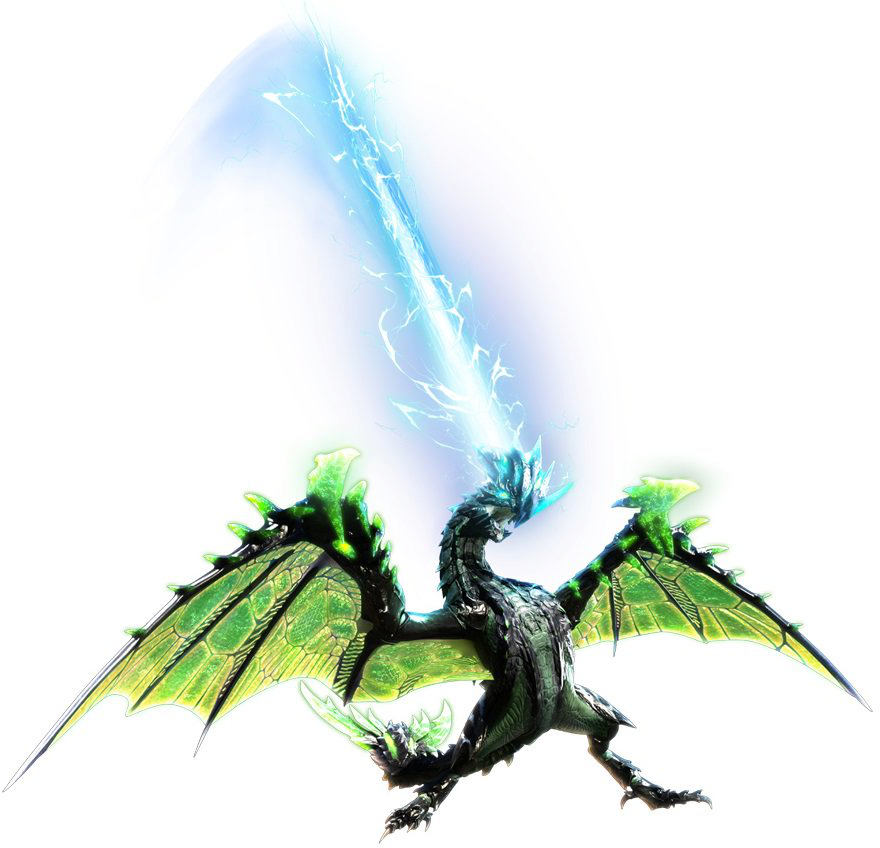
Rathian
Rathian is a true flying wyvern similar in looks to her male counterpart, Rathalos. Her hide is a dull, muted green in contrast to the Rathalos's deep red, and her lower mandible features a long, protruding chin spike. Her upper back and wingtips are covered in a moss-like fur not seen on the Rathalos, and while her clubbed tail lacks bony spikes, it makes up for this with its ability to poison foes upon contact.
Rathian, like her mate, can generate flaming projectiles from her mouth. She can use the poisonous barbs on her tail club to inflict blunt-force, toxic wounds on foes, even if her tail was cut off. Her powerful legs allow her to run at high speeds, making her easily capable of chasing down most prey. Like the Rathalos, her vision is very keen, so Flash Bombs are useful in combat.
Rathian is very territorial, choosing to patrol from ground while her Rathalos mate patrols from the sky. She will become very aggressive to potential threats, especially when in close proximity to her nest and young.
Rathians can survive in almost any territory, but prefers areas with average temperature for nesting. As a result, she is known to be encountered in a large variety of areas such as jungles, sandy plains, and forests.
Rathian
Huge wyvern (flying), unaligned
- Armor Class 17 (natural armor)
- Hit Points 133 (14d12+42)
- Speed 40 ft., fly 80 ft.
STR DEX CON INT WIS CHA 19 (+4) 12 (+1) 16 (+3) 5 (-3) 13 (+1) 6 (-2)
- Skills Acrobatics +4, Perception +4
- Damage Immunities poison
- Damage Resistances fire
- Condition Immunities charmed, frightened, poisoned
- Senses darkvision 60 Ft., passive Perception 14
- Languages -
- Challenge 8 (3,900 xp)
Actions
Multiattack. The rathian makes two attacks: one with its bite and one with its stinger. While flying, it uses its talons in place of its bite attack.
Bite. Melee Weapon Attack. +7 to hit, reach 10 ft., one target. Hit 17 (3d8 + 4) piercing damage.
Talons. Melee Weapon Attack. +7 to hit, reach 5 ft., one target. Hit 14 (3d6 + 4) slashing damage.
Stinger. Melee Weapon Attack. +7 to hit, reach 10 ft., one target. Hit 14 (3d6+4) piercing damage. The target must make a DC 15 Constitution saving throw, taking 17 (5d6) poison damage on a failed save, or half as much damage on a successful one.
Fireball (recharge 5-6). The rathian exhales a fireball to a point within 100 feet of it. Each creature in a 10-foot radius Sphere centered on that point must make a DC 15 Dexterity saving throw. On a failed save, the creature takes 42 (12d6) fire damage, or half as much damage on a successful one.
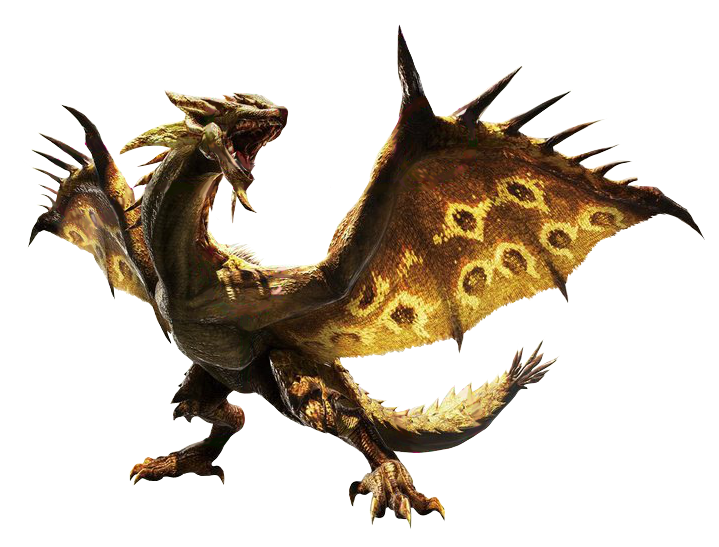
Rathalos
Rathalos are large, bipedal wyverns with a spiny, armored hide covering their body. Their outer shell features much brighter and more vibrant colors than that of their female counterpart, the Rathian. It is primarily bright red, with black markings throughout. Like the Rathian, Rathalos possess a flame sac which is used to produce deadly flaming projectiles from the mouth. The talons upon their feet are highly poisonous and are known to to inflict toxic mortal wounds on larger prey. In addition, their long, thick tail features a heavy spiked club at the end. Rathalos' wing membranes feature ornate patterns which are likely used to attract potential mates.
Rathalos are expert flyers, and as such are prone to hunting from the skies. By launching a surprise aerial attack, they can inflict poisonous wounds with their talons or burn prey with flaming projectiles. On the ground, Rathalos remain formidable opponents. Using their powerful legs, they can chase down prey from a distance. At a close enough range, they are known to use their sharp teeth to bite at foes as well. Some Rathalos are capable of staying in the air and launching a fireball before landing back to the ground.
Rathalos are highly territorial monsters, and as such, are aggressive towards intruders. They will chase away or attempt to kill any monster which may pose a threat to their land. While hunting, Rathalos will stalk prey from the air before swooping in for the kill. Once they have successfully brought down their prey, they will carry it away to eat in private, safe from scavengers or other large monsters which might attempt to steal the kill.
Rathalos have been spotted in many kinds of environments, from the temperate forest and hills to the extreme heat of a volcano. As a master of flight, they will travel far and wide, searching for prey from the skies.
Rathalos
Huge wyvern (flying), unaligned
- Armor Class 19 (natural armor)
- Hit Points 149 (13d12+65)
- Speed 40 ft., fly 80 ft.
STR DEX CON INT WIS CHA 21 (+5) 10 (+0) 21 (+5) 8 (-1) 13 (+1) 10 (+0)
- Skills Athletics +9, Perception +5
- Damage Immunities fire
- Damage Resistances poison
- Condition Immunities charmed, frightened
- Senses darkvision 60 Ft. passive Perception 15
- Languages -
- Challenge 10 (5,900 xp)
Actions
Multiattack. The rathalos makes two attacks: one with its bite and one with its talons. While flying, it uses its wings in place of its bite attack.
Bite. Melee Weapon Attack: +9 to hit, reach 10 ft., one target. Hit 18 (3d8 + 5) piercing damage.
Wings. Melee Weapon Attack: +9 to hit, reach 5 ft., one target. Hit 15 (3d6 + 5) bludgeoning damage.
Talons. Melee Weapon Attack: +9 to hit, 10 ft., one target. Hit 15 (3d6+5) slashing damage. The target must make a DC 17 Constitution saving throw, taking 24 (7d6) poison damage on a failed save, or half as much damage on a successful one.
Fireball (recharge 5-6). The rathalos exhales a fireball to a point within 100 feet of it. Each creature in a 10-foot radius Sphere centered on that point must make a DC 17 Dexterity saving throw. On a failed save, the creature takes 45 (13d6) fire damage, or half as much damage on a successful one.
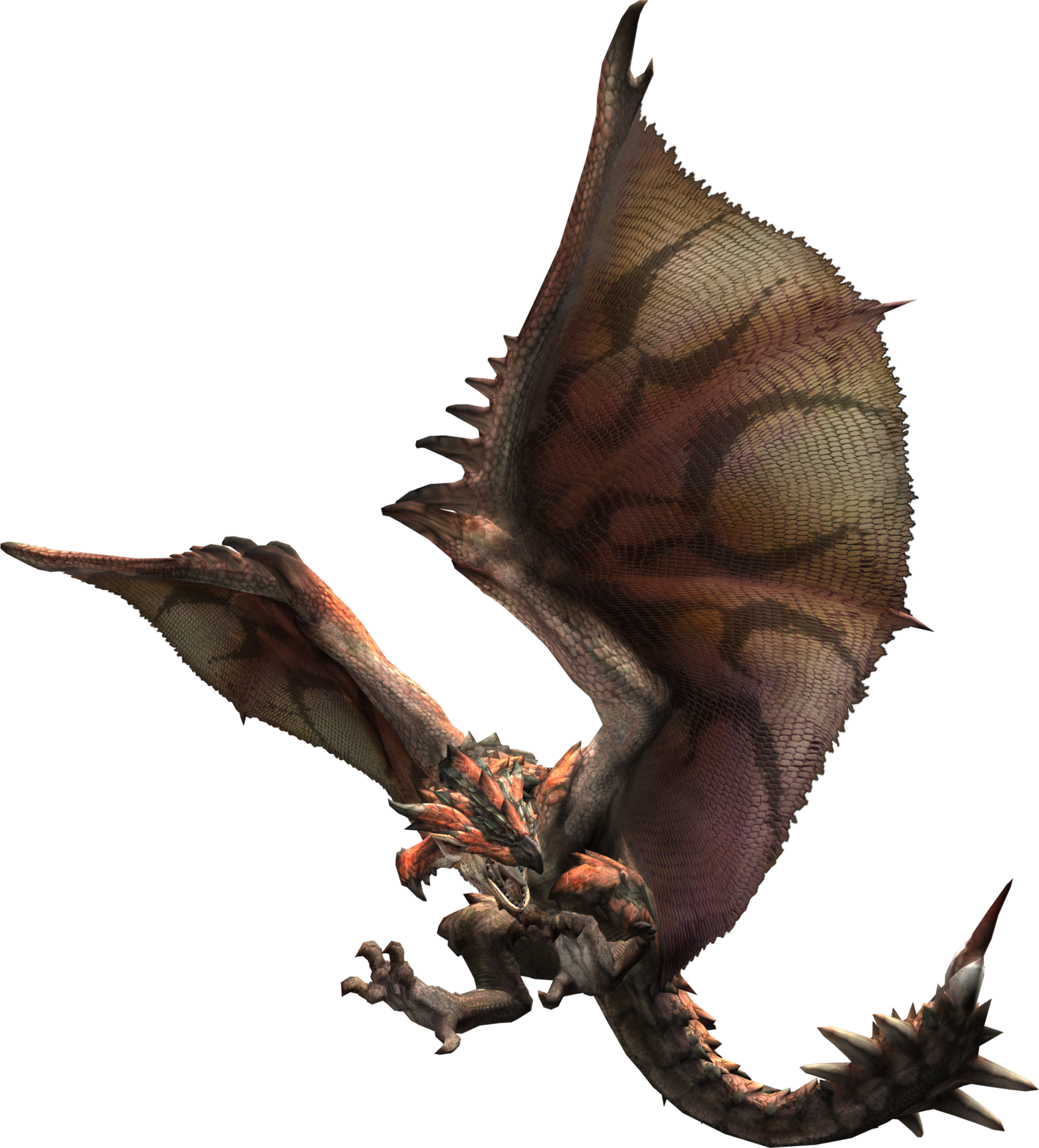
Khezu
Khezu are large, pale Wyverns with a flabby, rubbery hide which they constantly keep damp, similar to that of an amphibian. Many of their blood vessels and veins can be seen through their pale skin. Their tail features a specialized orifice which bonds to the ground during electrical attacks and helps them cling onto cave ceilings. Their mouth features rows of sharp teeth. Khezu feet lack claws, and instead have suction pad-like toes to assist them in climbing and hanging from cave walls and ceilings. Spending most of their lives in the dark, their eyes have regressed greatly, though they make up for this with a superb sense of smell. A layer of fat helps to keep them warm and prolong the time they can spend hunting for food. Khezu have an extendable neck which allows them to grasp and ambush prey from afar, such as from a cave ceiling. Khezu are hermaphrodites, which means an individual is both male and female. To reproduce they paralyze a creature and inject their young, known as Whelps. The Whelps grow inside their victim until it dies, or when they are strong enough to leave.
Although Khezu are cave dwellers, they go out when they please, or when food inside grows too scarce. While Khezu outside a cave are vulnerable to larger Wyverns like Tigrex, inside caves Khezu have the advantage. In addition to being unhampered by the dark, they can cling to the ceiling and attack from above.
A Khezu's habitat is often located near active sources of water; some sources claim this is because the water is excellent for conducting electricity into their prey, while others speculate that Khezu may need the dampness for their moist skin. Such areas include swamps and oceanside caves.
Khezu
Large wyvern (flying), unaligned
- Armor Class 17 (natural armor)
- Hit Points 189 (18d10 + 90)
- Speed 30 ft., fly 20 ft., climb 30 ft.
STR DEX CON INT WIS CHA 22 (+6) 9 (-1) 21 (+5) 5 (-3) 11 (+0) 1 (-5)
- Skills Perception + 4
- Damage Immunities lightning
- Condition Immunities blind, paralyzed, charmed
- Senses blindsight 60 ft., passive Perception 14
- Languages -
- Challenge 10 (5,900 xp)
Keen Smell. The khezu has advantage on Wisdom (Perception) checks that rely on smell.
Standing Leap. The khezu's long jump is up to 30 feet and its high jump is up to 15 feet, with or without a running start.
Electric Barrier. The khezu shrouds its body in electricity. Any creature that ends its turn within 5 feet of the khezu takes 15 (3d10) lightning damage.
Actions
Multiattack. The khezu makes three Lightning Ball attacks or it uses its Electric Current and two Bite attacks.
Bite. Melee Weapon Attack: +10 to hit, reach 15 ft., one target. Hit 17 (2d10 + 6) piercing damage.
Electric Current. The khezu releases a jolt of electricity all around it. Each creature within 5 feet of it must make a DC 17 Constitution saving throw or become paralyzed until the end of their next turn.
Lightning ball. Range Weapon Attack. +10 to hit, reach 60/100 ft., one target. Hit 14 (4d6) lightning damage and the target must make a DC 17 Constitution saving throw or become paralyzed until the end of their next turn.
Deadly Leap. If the khezu jumps at least 15 feet as part of its movement, it can then use this action to land on its feet in a space that contains one or more other creatures. Each of those creatures must succeed on a DC 18 Strength or Dexterity saving throw (target's choice) or be knocked prone and take 11 (2d6 + 4) bludgeoning damage plus 11 (2d6 + 4) lightning damage. On a successful save, the creature takes only half the damage, isn't knocked prone, and is pushed 5 feet out of the khezu's space into an unoccupied space of the creature's choice. If no unoccupied space is with in range, the creature instead falls prone in the khezu's space.
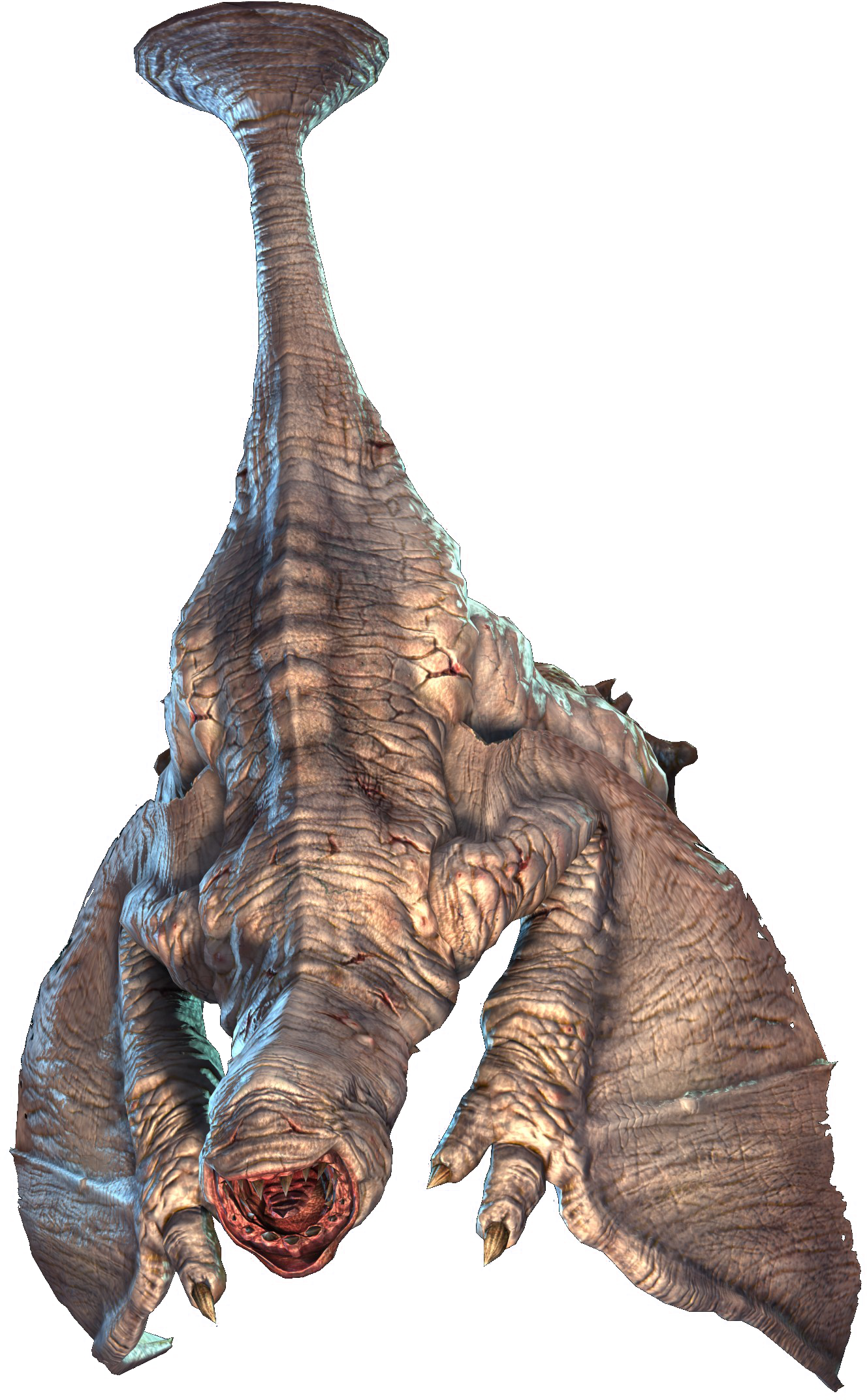
Nargacuga
Huge wyvern (flying), unaligned
- Armor Class 16 (natural armor)
- Hit Points 231 (22d12+88)
- Speed 50 ft., fly 30 ft.
STR DEX CON INT WIS CHA 22 (+6) 17 (+3) 18 (+4) 8 (-2) 14 (+2) 6 (-2)
- Skills Perception, +5, Stealth +7
- Senses darkvision 120 ft., passive Perception 15
- Languages -
- Challenge 11 (7,200 xp)
Shadow Stealth. While in dim light or Darkness, the nargacuga can take the Hide action as a Bonus Action. Its stealth bonus is also improved to +11.
Actions
Multiattack. The nargacuga makes three attacks: one with its bite, one with its bladed wings, and one with its tail swipe. Or it makes two tail spike attacks.
Bite. Melee Weapon Attack: +10 to hit, reach 5 ft., one target. Hit 19 (3d8 + 6) piercing damage.
Bladed Wings. Melee Weapon Attack: +10 to hit, reach 5 ft., one target. Hit 16 (3d6 + 6) slashing damage.
Tail Swipe. Melee Weapon Attack: +10 to hit, reach 10 ft., one target. Hit 25 (3d12 + 6) bludgeoning damage.
Tail Spikes. Range Weapon Attack: +10 to hit, reach 30/120 ft., one target. Hit 22 (3d10 + 6) piercing damage.
Feral Pounce (recharge 5-6). The nargacuga leaps towards its target, jumping 10 feet, as part of its movement, and attacks with both its claws. The target must make on a DC 18 Dexterity saving throw. On a failed save the target takes takes 44 (8d10) piercing damage and they are knocked prone. On a success the target takes half damage and is not knocked prone. Additionally, if the target is prone or knocked prone, the nargacuga can make one bite attack against it as a bonus action.
Nargacuga
It has black scales, black fur and nightmarish red eyes, giving it the look and style of a predatory black panther. Its dark, feral appearance suggests that it may mainly be a nocturnal predator. When it's enraged, its eyes glow bright red and leave a trail of reddish lines when Nargacuga moves. Nargacuga has the ability to attack with almost every part of its body, mainly its bladed wings and its spiked tail. Its tail erects large spikes which can be flung and linked up with its attacks for devastating hits. Their vertebrae and tail muscles are extremely flexible, making the tail of Nargacuga also prehensile. Its tail is also its most powerful weapon. The scales at the end of the tail can also be shaken to produce rattling sounds similar to that of a rattlesnake.
Nargacuga is a careful and cautious monster. It is very easy for it to sneak up to a hunter. Nargacuga lives in dark places that it has adapted to. It rests on high trees that are hard to reach, or maybe can't be reached, so hunters can't catch it by surprise for capturing it. Nargacuga will wake up when hunters are right in front of the tree due to its natural senses.
Nargacuga are normally and mainly found in the great forests. Although occasionally, Nargacuga can be found in swamps, jungles and, very rarely in the mountain ranges or the plains.
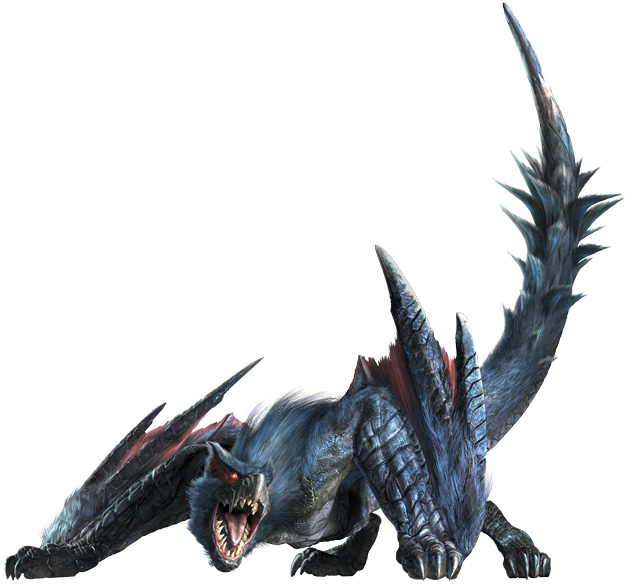
Monoblos
A monoceros desert-dwelling wyvern, they have a brown, rock-hard texture to their shell.
While Monoblos have no breath attack, their roar is considered a lethal weapon itself. They are also very physically capable, able to fight off adventurers with horn-thrusts and tail-swings. Being able to tunnel beneath the sands of the Desert also means they can sneak up on any potential threats.
Monoblos are aggressive, and will attack adventurers on sight. They are quick to anger, causing their crown to be become inflamed with red streaks.
Monoblos
Huge wyvern (flying), unaligned
- Armor Class 19 (natural armor)
- Hit Points 195 (17d12 + 85)
- Speed 40 ft., burrow 30 ft.
STR DEX CON INT WIS CHA 24 (+7) 13 (+1) 21 (+5) 4 (-3) 10 (+0) 5 (-3)
- Saving Throws Wis +4
- Senses darkvision 60 ft., tremorsense 60 ft., passive Perception 10
- Languages -
- Challenge 12 (8,400 xp)
Underground Charge. If the monoblos moves at least 20 feet straight toward a creature while underground, it can then make a horn attack as a bonus action.
Relentless (Recharges after a Short or Long Rest). If the monoblos takes 30 damage or less that would reduce it to 0 hit points, it is reduced to 1 hit point instead.
Brute. A melee weapon deals one extra die of its damage when the monoblos hits with it (included in the attack).
Actions
Multiattack. The monoblos makes two attacks, one with its horn and one with its tail attack.
Horn. Melee Weapon Attack: +11 to hit, reach 5 ft., one target. Hit 29 (4d10 + 7) piercing damage.
Tail. Melee Weapon Attack. +11 to hit, reach 10 ft., one target. Hit 25 (4d8 + 7) bludgeoning damage.
Violent Roar (Recharge 5-6). The monoblos roars loudly in a 10 foot radius around them. All creatures in this area must make a DC 17 Constitution saving throw, taking 35 (10d6) thunder damage and become Deafened for 1 minute on a failed saving throw or half as much on a successful one and is not deafened.
Diablos
Diablos are large, bipedal wyverns with powerful armor plating covering much of their body. Their most noteworthy feature is a pair of massive, solid horns above their eyes. Diablos also possess a pair of tusk-like fangs and a large, spiny neck frill. Their tail ends with a heavy, studded club that can be used to ward off attackers. Diablos stand on a pair of stocky, wide-set legs and possess a broad upper body complete with thick, muscular wings.
Diablos have the ability to burrow into the earth and travel underground, employing this tactic to surprise unsuspecting targets or slip away from a dangerous encounter. In addition, they are capable of producing a powerful roar that will stun most aggressors. Using their powerful legs in tandem with their heavy upper body and head, Diablos can run at high speeds to charge attackers with their horns, using the powerful momentum to maximize the potential for damage.
Diablos are herbivores, known to feed on the plentiful cacti of the desert. Despite this however, they are wildly aggressive and will pursue anything which enters their territory. Diablos are known to use their horns as weapons against attackers, but will also use them in bouts against other Diablos in battles for territory or mating rights. Diablos typically avoid flight for the purpose of transportation, as a disproportionately high mass prevents them from effectively flying for long periods of time. Instead, Diablos will use their wings to free themselves when trapped in the sand.
Diablos are commonly found in dry, arid desert environments. The soft, loose earth allows for digging and the water-rich cacti provide them with both nutrition and hydration.
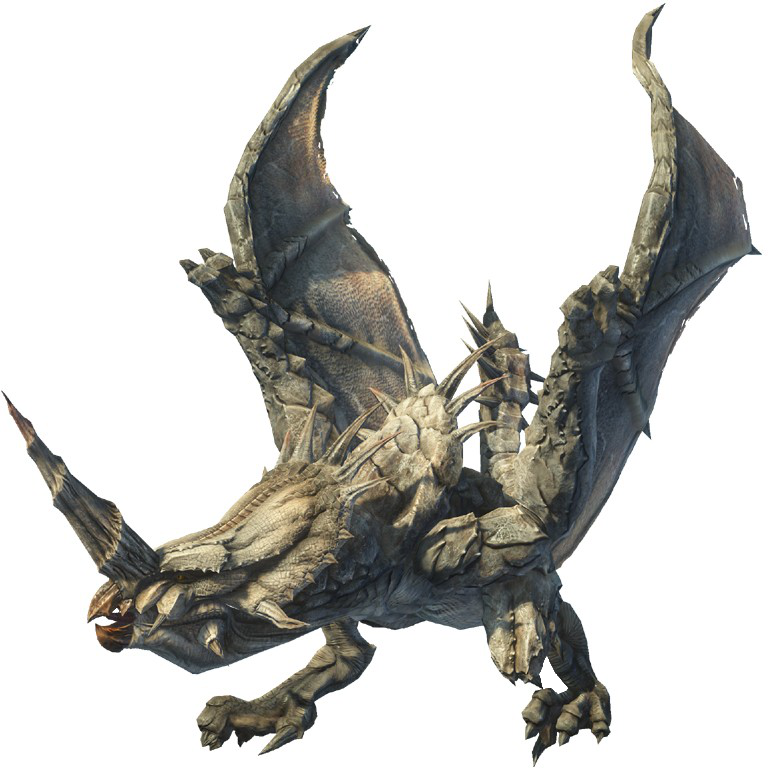
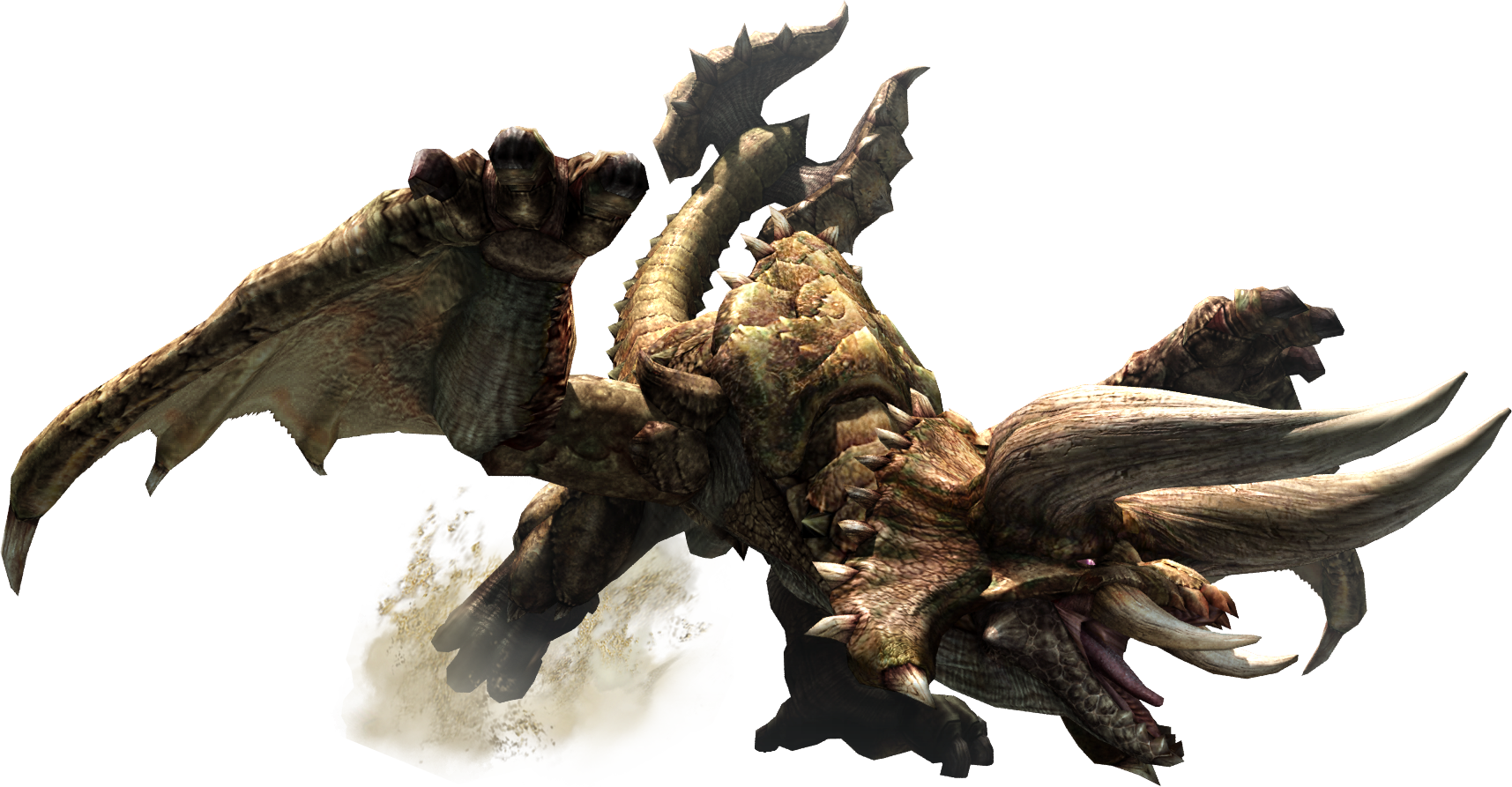
Diablos
Huge wyvern (flying), unaligned
- Armor Class 20 (natural armor)
- Hit Points 200 (16d12 + 96)
- Speed 40 ft., burrow 30 ft.
STR DEX CON INT WIS CHA 25 (+7) 13 (+1) 23 (+6) 6 (-2) 14 (+2) 9 (-1)
- Saving Throws Wis +8
- Condition Immunities frightened
- Senses darkvision 60 ft., tremorsense 60 ft., passive Perception 12
- Languages -
- Challenge 18 (20,000 xp)
Underground Charge. If the diablos moves at least 20 feet straight toward a creature while underground, it can then make a horn attack as a bonus action.
Brute. A melee weapon deals one extra die of its damage when the diablos hits with it (included in the attack).
Legendary Resistance (2/Day). If the diablos fails a saving throw, it can choose to succeed instead.
Actions
Multiattack. The diablos makes two attacks, one with its horn and one with its tail attack.
Horn. Melee Weapon Attack: +13 to hit, reach 5 ft., one target. Hit 29 (4d10 + 7) piercing damage.
Tail. Melee Weapon Attack. +13 to hit, reach 10 ft., one target. Hit 25 (4d8 + 7) bludgeoning damage.
Violent Roar (Recharge 5-6). The diablos roars loudly in a 15 foot radius around them. All creatures in this area must make a DC 22 Constitution saving throw, taking 45 (10d8) thunder damage and become Deafened for 1 minute on a failed saving throw or half as much on a successful one.
Legendary Actions
The diablos can take 3 legendary actions, choosing from the options below. Only one legendary action option can be used at a time and only at the end of another creatures turn. The diablos regains spent legendary actions at the start of its turn.
Dig. The diablos burrows underground and moves up to half its burrow speed.
Attack. The diablos makes a Horn or Tail attack.
Quake (Costs 2 Actions). The diablos strikes the ground with its maul like tail, triggering a tremor. All creatures on the ground within 60 feet of the diablos must succeed on a DC 19 Strength saving throw or be knocked prone.
Legiana
Legiana is a slim, primarily beige-coloured Flying Wyvern characterised by its leaf-like wingtips and striped skin patterns. Legiana's head is topped with a pair of antenna-like fins which are attached via a thin membrane to the back of its neck. It has bright yellow eyes and powerful legs ending in piercing talons. Its face, tail, feet, and wingtips are a dark navy blue, and its body is covered in striped patterns of the same colour. The ends of its wings are separated into four distinct flaps which overlap each other when folded. Legiana has star-like shapes on the back of its wings. Its back is also dark blue.
Legiana is able to emit a chilling wind from its body, which dulls its prey's ability to escape. It flies with extreme precision and agility, using its talons to grab its prey straight out of the air. Its legs are strong enough to throw even medium-sized monsters such as Paolumu considerable distances once they are in its grasp.
Disease: Iceblight
A creature who is afflicted with iceblight is chilled to the bone.
- The creature can't use reactions.
- Its speed is halved.
- It can't make more than one attack on its turn.
Legiana
Huge wyvern (flying), unaligned
- Armor Class 17 (natural armor)
- Hit Points 187 (15d12+90)
- Speed 40 ft., fly 80 ft.
STR DEX CON INT WIS CHA 22 (+6) 12 (+1) 22 (+6) 8 (-1) 12 (+1) 12 (+1)
- Saving Throws Dex +6, Con+11, Wis +6, Cha +6
- Skills Acrobatics +11, Perception +11
- Damage Immunities cold
- Senses darkvision 60 ft., passive Perception 21
- Languages -
- Challenge 13 (10,000 xp)
Flyby. The legiana doesn't provoke an opportunity attack when it flies out of an enemy's reach.
Frost. A creature that starts its turn or moves into an area covered in frost must make a DC 18 Constitution saving throw or become diseased with iceblight for 1 minute.
Legendary Resistance (3/Day). If the legiana fails a saving throw, it can choose to succeed in stead.
Actions
Multiattack. The legiana makes three attacks: one with its bite, one with its talons, and one with its tail.
Bite. Melee Weapon Attack. +11 to hit, reach 10 ft., one target. Hit 16 (3d6 + 6) piercing damage.
Tail. Melee Weapon Attack. +11 to hit, reach 15 ft., one target. Hit 19 (3d8 + 6) bludgeoning damage plus 7 (2d6) cold damage and leaves a layer of frost in an area that is 10 feet long and 15 feet wide centered on the target or 30 feet long and 5 feet wide in front of the legiana until the start of its next turn.
Talons. Melee Weapon Attack. +11 to hit, reach 10 ft., one target. Hit 16 (3d6 + 6) piercing damage and the target is grappled (Escape DC 19)
Corkscrew (recharge 5-6). The legiana moves up to half of its fly speed in a straight line, covering the ground below it in frost while it does. While doing so, it can enter Large or smaller creatures' spaces. The first time the legiana enters a creature's space, the creature must make a DC 19 Dexterity saving throw.
On a failed save, the creature takes 28 (8d6) bludgeoning damage plus 10 (3d6) cold damage and is knocked prone.
On a successful save, the creature takes half damage and can choose to be pushed 5 feet to the side of the legiana. A creature that chooses not to be pushed suffers the consequences of a failed saving throw.
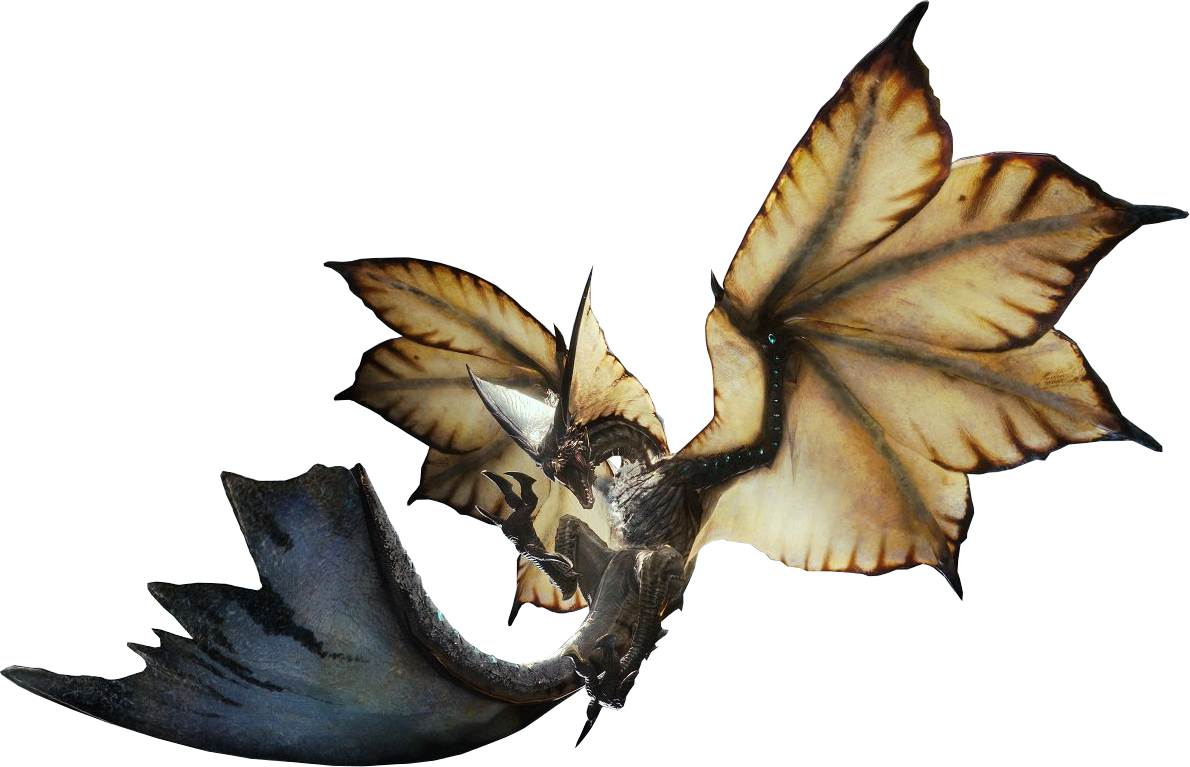
Barioth
Barioth is a quadrupedal Flying Wyvern, with various cat-like features. Its body is mostly covered with icy white plates and spikes along its neck, spine, and tail. Its face features two massive, curved tusks of an amber coloration. Its forelegs are longer and more powerful than its back legs, with deadly spikes along its wings, as well as two large claws.
Barioth move quickly and attack wildly, presenting a challenge even to experienced adventurers. Barioth uses its fangs and claws to slide around on the ice making it hard to keep up with. It is able to slide its tail to its side and wield it in a club-like fashion. It is capable of producing a wind blast; Barioth will spit out an icy ball that will create a powerful tornado.
Barioth is highly aggressive and territorial. It will attack any hunter that enters its domain. It will eat Popo or Anteka when fatigued.
Barioth inhabits icy areas such as the Tundra or the Snowy Mountains, where the roaming herbivores on which it preys are large and plentiful.
Barioth
Huge wyvern (flying), unaligned
- Armor Class 16 (natural armor)
- Hit Points 207 (18d12+90)
- Speed 50 ft., fly 40 ft.
STR DEX CON INT WIS CHA 15 (+2) 23 (+6) 20 (+5) 10 (+0) 14 (+2) 8 (-1)
- Saving Throws Dex +11, Wis +7, Cha +4
- Damage Immunities cold
- Damage Resistances bludgeoning, piercing, slashing damage from nonmagical weapons
- Senses darkvision 60 ft., passive Perception 12
- Languages -
- Challenge 15 (13,000 xp)
Actions
Multiattack. The barioth makes three attacks: one with its bite and two claw attacks.
Bite. Melee Weapon Attack: +11 to hit, reach 10 ft., one target. Hit 19 (3d8 + 6) piercing damage.
Claw. Melee Weapon Attack: +11 to hit, reach 5 ft., one target. Hit 13 (2d6 + 6) slashing damage.
Tail Swipe. Melee Weapon Attack: +11 to hit, reach 10 ft., one target. Hit 22 (3d10 + 6) cold damage. The target and each creature within 5 foot radius of the target must make a DC 15 Strength saving throw. On a fail, they are pushed back 10 feet from the barioth and knocked prone. On a success, they are still knocked back but are not prone.
Vortex (recharge 5-6) The barioth creates a 15-foot wide vortex within 60 feet of it. Each creature in that area must make a DC 18 Dexterity saving throw, taking 22 (5d8) bludgeoning damage and 7(2d6) cold damage on a failed save or half on a successful save.
Legendary Actions
The barioth can take 3 legendary actions, choosing from the options below. Only one legendary action option can be used at a time and only at the end of another creatures turn. The barioth regains spent legendary actions at the start of its turn.
Detect. The barioth makes a Wisdom (Perception) Check.
Tail Swipe. The barioth uses its tail swipe.
Ice Slide (Costs 2 Actions). The barioth moves up to its speed, during this move it may move through other creatures. Any creatures the barioth moves through must succeed on a DC 19 Dexterity saving throw or take 20 (3d8+6) slashing damage and be knocked prone.
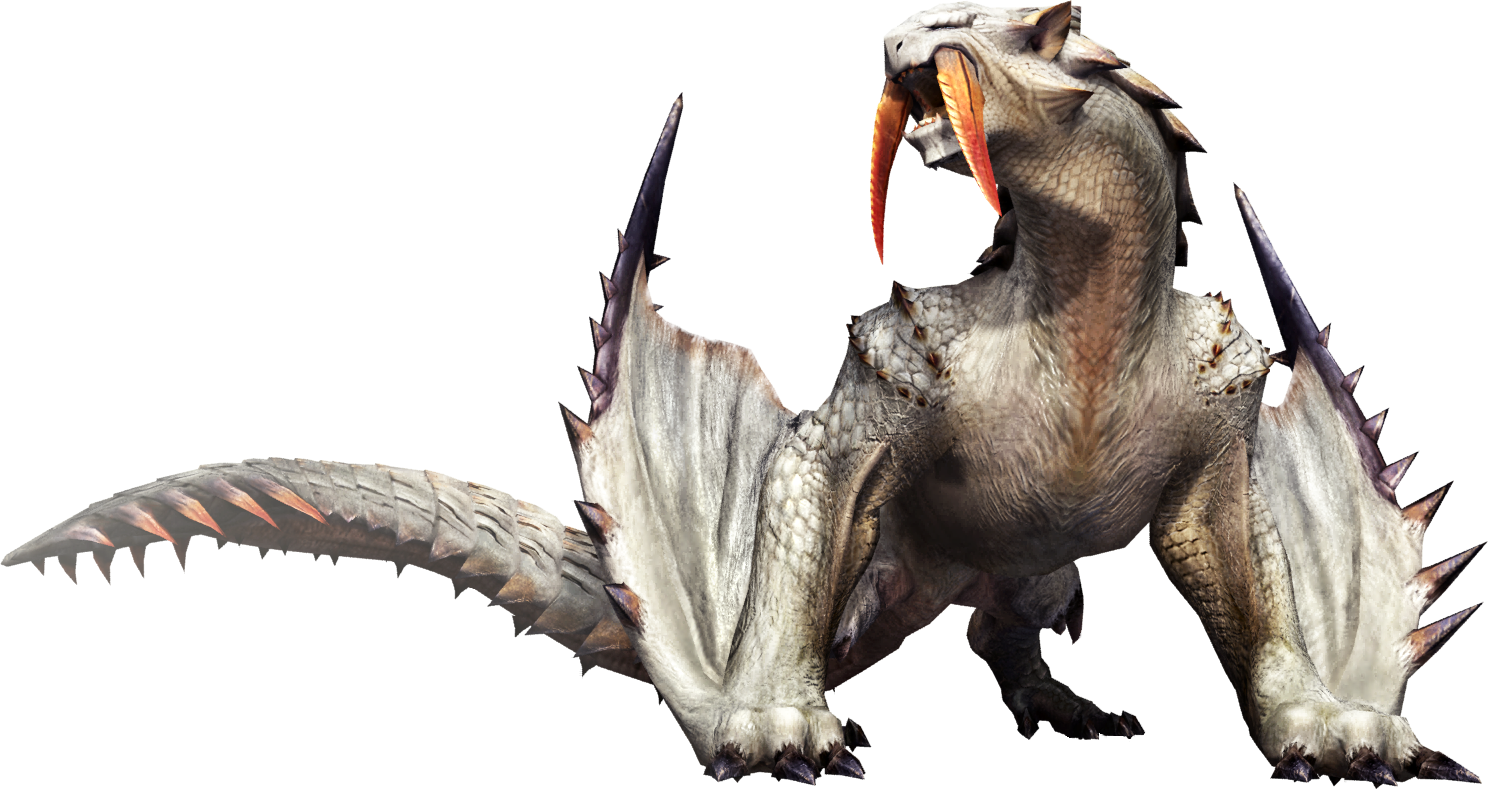
Tigrex
Huge wyvern (flying), unaligned
- Armor Class 18 (natural armor)
- Hit Points 189 (18d12 + 72)
- Speed 50 ft., fly 40 ft.
STR DEX CON INT WIS CHA 23 (+6) 16 (+3) 19 (+4) 8 (-1) 12 (+1) 10 (+0)
- Saving Throws Dex +8 Wis +6
- Skills Athletics +11
- Senses darkvision 60 ft., passive Perception 16
- Languages -
- Challenge 16 (15,000 xp)
Enrage (1/day). The first time the tigrex hp drop below half of its maximum, it enrages for 1 minute. While enraged, the tigrex damage is increased by +5 and its movement is increased by 10 ft.
Legendary Resistance (2/Day). If the tigrex fails a saving throw, it can choose to succeed instead.
Actions
Multiattack. The tigrex makes three attacks, one with its bite and two with its claws.
Bite. Melee Weapon Attack: +11 to hit, reach 5 ft., one target. Hit 19 (3d8 + 6) piercing damage
Claw. Melee Weapon Attack: +11 to hit, reach 5 ft., one target. Hit 13 (2d6 + 6) slashing damage.
Tail. Melee Weapon Attack: +11 to hit, reach 5 ft., one target. Hit 22 (3d10 + 6) bludgeoning damage.
Violent Roar (Recharge 5-6). The tigrex roars loudly in a 15 foot radius around them. All creatures in the area become deafened for 1 minute and must make a DC 17 Constitution saving throw, taking 49 (9d10) thunder damage on a failed saving throw or half as much on a successful one.
Legendary Actions
The tigrex can take 3 legendary actions, choosing from the options below. Only one legendary action option can be used at a time and only at the end of another creatures turn. The tigrex regains spent legendary actions at the start of its turn.
Detect. The tigrex makes a Wisdom (Perception) Check.
Tail Attack. The tigrex makes a tail attack.
Trample (Costs 2 Actions). The tigrex moves up to its speed, during this move it may move through other creatures without provoking attacks of opportunity. Any creatures the tigrex moves through must succeed on a DC 16 Dexterity saving throw or take 16 (3d6 + 6) bludgeoning damage and are knocked prone.
Tigrex
Tigrex is a large, quadrupedal wyvern characterized by its massive head and jaws, powerful limbs and striking yellow/blue striped coloration. The top of its head is tipped with a pair of horn-like ears, and its segmented tail ends with a spiny protrusion.
As a quadrupedal wyvern, its wings have evolved into forelegs, which allows it to run at very fast speeds. Though it possesses a pair of adequately-developed wings, it is rarely seen flying in a traditional sense. It is in fact more prone to gliding from location to location. It has a powerful set of lungs which gives it the ability to produce extremely loud, concussive roars which can physically damage nearby objects. The Tigrex relies on its sheer brute strength to bring down opponents.
When idle, Tigrex will assume a bipedal gait, standing only upon its hind legs while holding its forelimbs at its side. When threatened or engaging prey, however, it will stand upon all fours and ready itself for combat. It will usually attempt to intimidate would-be attackers with an ear-splitting roar. The Tigrex can be found in many different environments. If combat becomes intense enough, it will flush blood to its forelimbs, face, and eyes, in order to give its skin a bright-red glow as an effort to further intimidate attackers. Like many wyverns, it will travel far and wide in search of prey.
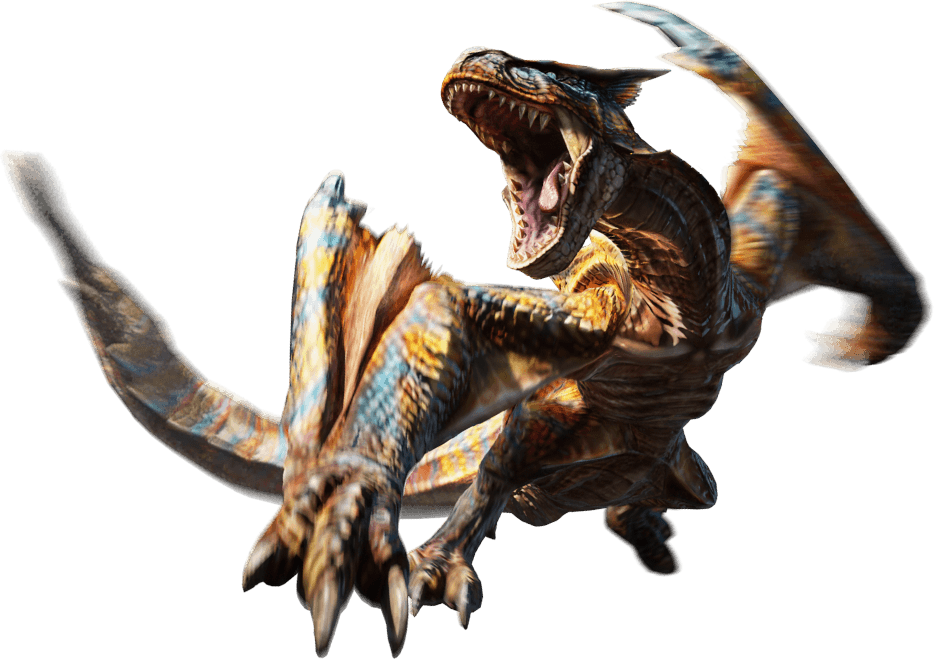
Bazelgeuse
Bazelgeuse is a large Flying Wyvern covered in thick, heavy scales with a bronzy sheen. It has a bulky upper body and a large wingspan. Its underside is lined with protruding scales which are easily shed. The monster occasionally enters a "superheated" state, causing the gaps between its scales to glow red hot.
The Bazelgeuse's most distinctive trait is its ability to shed explosive scales. These special scales are created by solidifying its body fluids. Once dislodged, these scales explode after a time, acting as a sort of timed mine. However, when the monster enters its "superheated" state, the scales detonate almost immediately. It uses its enormous body to overwhelm other monsters and the power of its scales to soften them up. Bazelgeuse will shed their explosive scales over a wide area in a sort of carpet bombing so they can prey on whatever gets caught in the blast.
They are nomadic predators and can be found all across the continent. Bazelgeuse easily assert themselves as apex monsters in whatever environment they pass through, disrupting the local food chain, it will readily fight other large monsters. They will even dive into fights that doesn't even involve them and can be seen as having a lust for combat. They will attack monsters regardless of their standing but seem to gravitate more towards other apex monsters.
Bazelgeuse
Huge wyvern (flying), unaligned
- Armor Class 20 (natural armor)
- Hit Points 276 (24d12+120)
- Speed 40 ft., fly 80 ft.
STR DEX CON INT WIS CHA 23 (+6) 10 (+0) 21 (+5) 10 (+0) 13 (+1) 12 (+1)
- Saving Throws Dex +6, Con +11, Wis +7, Cha +7
- Damage Immunities fire
- Damage Resistances cold; bludgeoning, piercing, slashing from nonmagical weapons
- Senses passive Perception 11
- Languages -
- Challenge 17 (18,000 xp)
Explosive Scales. The bazelgeuse scales, when dislodged from its body, act as a time bomb. On initiative count 20 (losing all initiative ties) all scales explode dealing 10 (3d6) fire damage to all creature in a 5-foot radius of them.
Shed. Whenever the bazelgeuse makes a melee weapon attack it dislodges an explosive scale which lands in an unoccupied space with 5 feet of its location.
Carpet Bomb. For every 20 feet the bazelgeuse flies, it dislodges an explosive scale which lands in an unoccupied space directly below it.
Wounded Fury. While it has 56 hit points or fewer, the bazelgeuse enters a "superheated" state gaining advantage on attack rolls. In addition, Explosive Scales detonate at the end of the bazelgeuse's turn.
Dive Attack. If the bazelgeuse is flying and dives at least 30 feet straight toward a target and then hits it with a headbutt attack, the attack deals an extra 4 (1d8) damage to the target.
Actions
Multiattack. The bazelgeuse makes three attacks: one headbutt attack, one tail attack, and wing attack.
Headbutt. Melee Weapon Attack. +12 to hit, reach 5 ft., one target. Hit 19 (3d8 + 6) bludgeoning damage.
Wing. Melee Weapon Attack. +12 to hit, reach 5 ft., one target. Hit 22 (3d10 + 6) bludgeoning damage.
Tail. Melee Weapon Attack. +12 to hit, reach 10 ft., one target. Hit 16 (3d6 + 6) bludgeoning damage.
Fire Breath (Recharge 5-6). The bazelgeuse exhales fire in a 45-foot cone. Each creature in that area must make a DC 21 Dexterity saving throw, taking 46 (7d12) fire damage on a failed save, or half as much damage on a successful one.
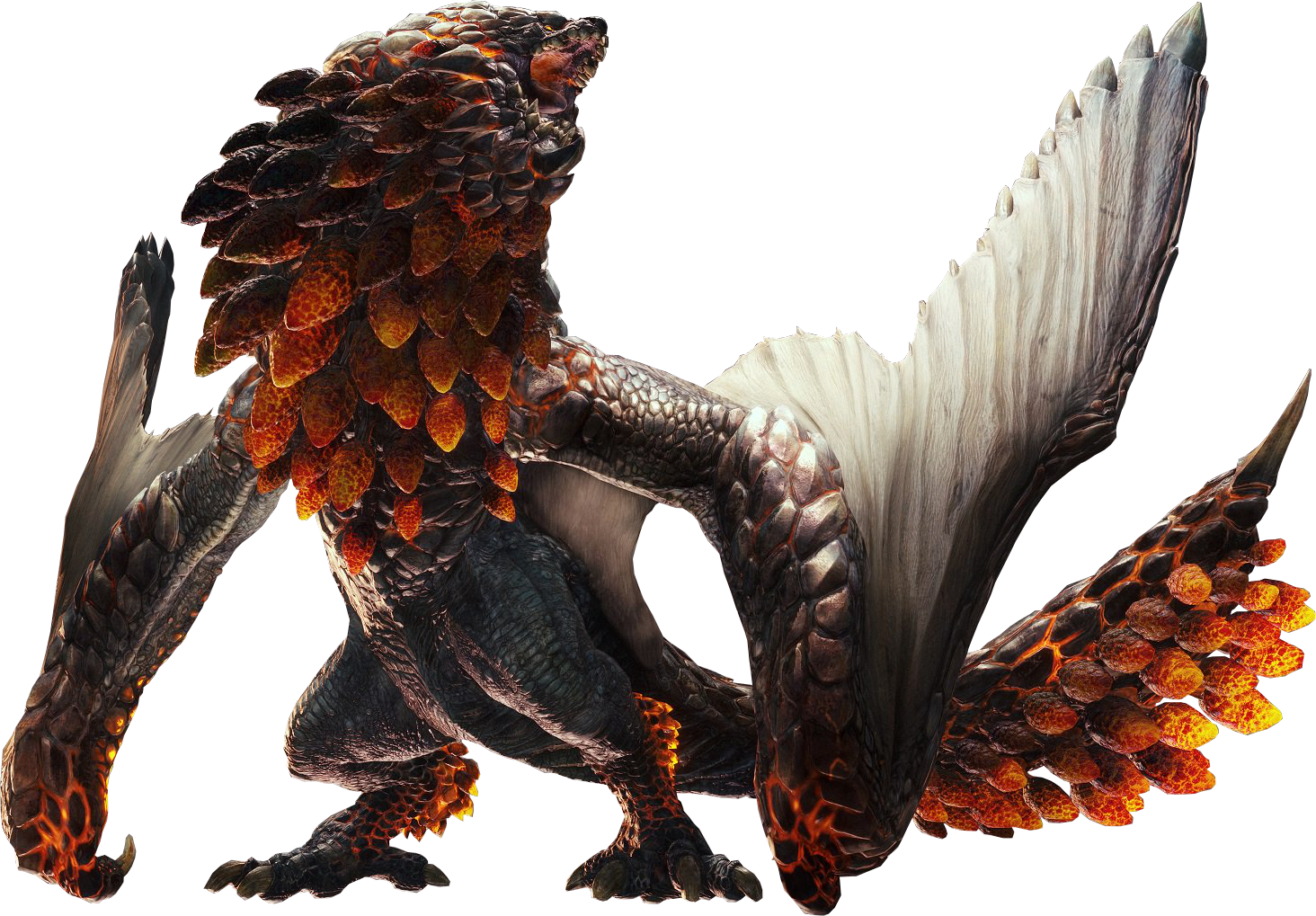
Ukanlos
A mysterious wyvern said only to appear after large avalanches deep in the snowy mountains. Often seen crushing ice balls and rock into powder in its stride, it's known to most as Ukanlos, although there are whisperings it may be the white god... Ukanlos is a Flying Wyvern that is closely related to the Akantor. Originally, like Akantor, Ukanlos was classified as a Elder Dragon due to it not fitting in any other class but after much research it has been found to be a large species of Flying Wyvern.
Ukanlos are apex predators that can virtually feed on anything they'd want. Animals like Popo, Bulldrome, and Anteka are common prey. However being indiscriminate feeders Ukanlos will also prey on other predators such as Tigrex, Barioth, Khezu, Blangonga, Abiorugu, Doragyurosu, Deviljho and even Elder Dragons such as Kirin or Kushala Daora are fair game for these behemoths. Ukanlos will also eat the ice and absorb minerals, however this beast is rather large so the amount of ice it would have to eat would be huge.
Ukanlos closely resembles Akantor in body structure and possesses the same quadrupedal gait. It has a silvery-white carapace which features a row of large, jagged fins along its back. It has a small, compact face which features glowing yellow eyes, sharp teeth, and a massive, shovel-like jaw. Its massive serrated shovel-like jaw allows it to fling up large chunks of ice and to dig through the ice with ease. Ukanlos has grown an extremely tough and streamlined carapace with large razor sharp fins running along its spine to "swim" through the ice.
The Ukanlos can produce an ice beam from its mouth to attack anything foolish enough to attempt to harm it, and is known to use its heavy body weight to crush opponents and its jaws are capable of crushing ice and rock alike. Despite its great size and weight, Ukanlos is known to be able to leap significant distances. In order to survive the weather this creature may have a large layer of fat underneath its hard shell. This layer of flesh is visible underneath its forearms, showing a light-blue underflesh. This beast also hibernate for vast periods of time to survive after feeding.
Ukanlos lives a solitary life, and has only ever been encountered in remote, frozen regions. It is fiercely territorial to any who intrude upon its land. Ukanlos have been found to attack and destroy villages that are built in its territory after waking from hibernation.
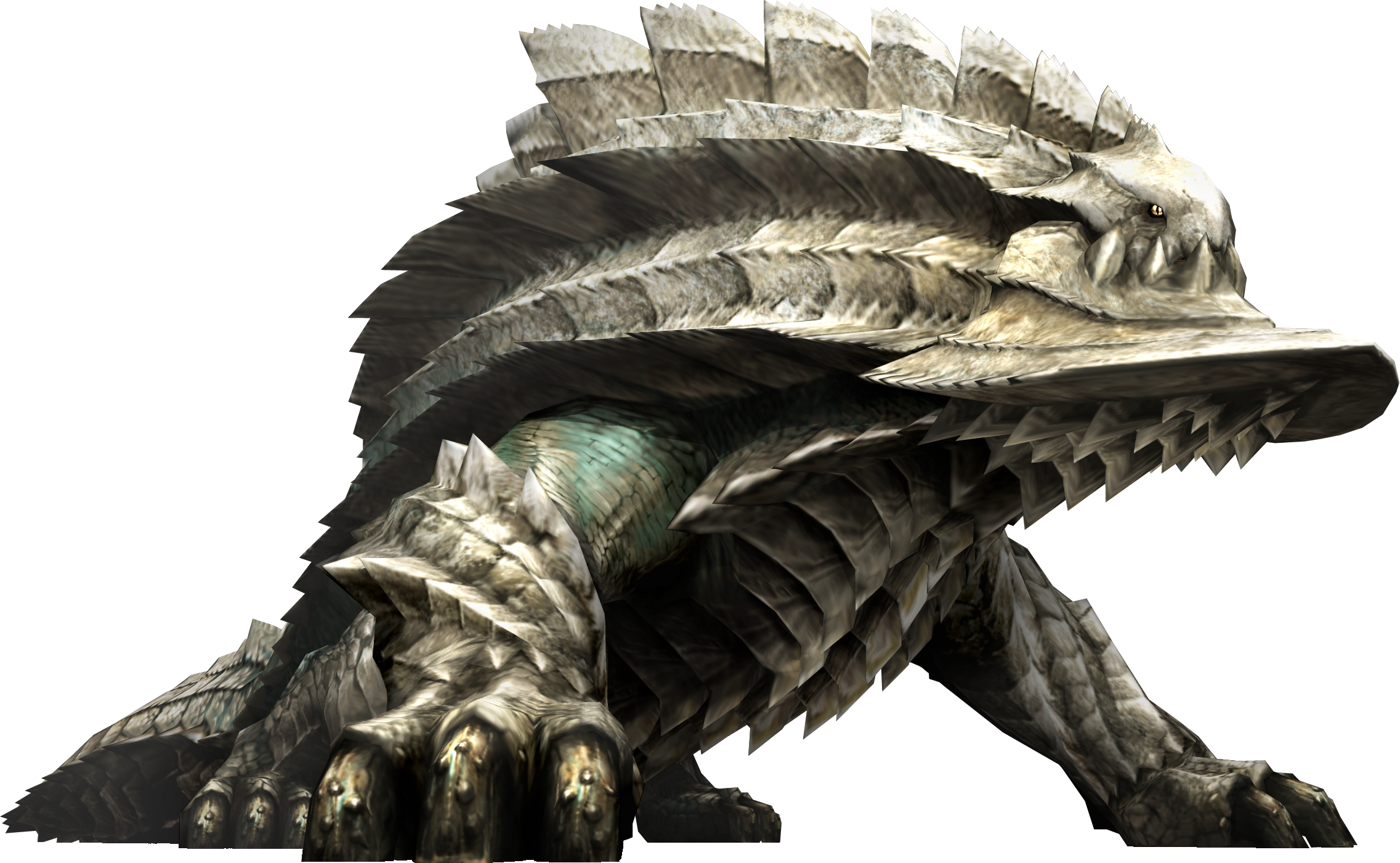
Ukanlos
Gargantuan wyvern (flying), unaligned
- Armor Class 20 (natural armor)
- Hit Points 277 (15d20 + 120)
- Speed 40 ft., burrow 30 ft.
STR DEX CON INT WIS CHA 24 (+7) 14 (+2) 26 (+8) 10 (+0) 13 (+1) 10 (+0)
- Saving Throws Dex +8, Con + 14, Wis +7
- Skills Perception +7
- Damage Immunities cold; bludgeoning, piercing, slashing damage from nonmagical weapons
- Condition Immunities charmed, frightened, paralyzed
- Senses darkvision 120 ft., tremorsense 120 ft., passive Perception 17
- Languages -
- Challenge 20 (25,000 xp)
Ice Walk. The ukanlos can move across and climb icy surfaces without needing to make an ability check. Additionally, difficult terrain composed of ice or snow doesn't cost it extra moment.
Magic Resistance. The ukanlos has advantage on saving throws against spells and other magical effects.
Legendary Resistance (3/Day). If the ukanlos fails a saving throw, it can choose to succeed instead.
Actions
Multiattack. The ukanlos makes three attacks; one with its bite, one with its claw and one with its tail.
Bite. Melee Weapon Attack: +13 to hit, reach 10 ft., one target. Hit 29 (4d10 + 7) piercing damage. If the target is a creature, it is grappled (escape DC 21) . Until this grapple ends, the target is restrained, and the ukanlos can't bite another target.
Claw. Melee Weapon Attack: +13 to hit, reach 15 ft., one target. Hit 13 (2d6 + 7) slashing damage.
Tail. Melee Weapon Attack: +13 to hit, reach 20 ft., one target. Hit 25 (4d8 + 7) bludgeoning damage.
Ice Beam (Recharge 5-6). exhales a stream of ice in a 120-foot line that is 10 feet wide. Each creature in that line must make a DC 21 Dexterity saving throw, taking 45 (13d6) cold damage and is restrained by the ice on a failed save, or half as much damage on a successful one and is not restrained.
The restrained creature can make a DC 18 Strength check, escaping from the ice on a success. The effect ends if the ice is destroyed. The ice has AC 12, 30 hit points, resistance to slashing and piercing damage, immunity to poison and psychic damage, and vulnerable to fire damage.Crush. If the ukanlos uses all of its movement to rise up on its hind legs. It can then use its action to slams its body in an area within 20 feet of its location that contains one or more other creatures. Each of those creatures must succeed on a DC 22 Strength or Dexterity saving throw (target's choice) or be knocked prone and take 21 (4d6 + 7) bludgeoning damage + 21 (4d6 + 7) cold damage. On a successful save, the creature takes only half the damage, isn't knocked prone, and is pushed 5 feet out of the ukanlos's space into an unoccupied space of the creature's choice. If no unoccupied space is with in range, the creature instead falls prone in the ukanlos's space.
Launch. The Ukanlos digs its shovel-like jaw into the ground under a creature or object. If it is a creature, they must make a DC 22 Dexterity saving throw or be tossed 30 feet up in the air and 15 feet away from the Ukanlos taking 10 (3d6) upon landing. If there is a creature in the location the target lands, they must make the same saving throw or take the same amount of damage.
Legendary Actions
The ukanlos can take 3 legendary actions, choosing from the options below. Only one legendary action option can be used at a time and only at the end of another creatures turn. The ukanlos regains spent legendary actions at the start of its turn. if a creature is in
Toss. The ukanlos uses its Launch.
Detect. The ukanlos makes a Wisdom (Perception) Check.
Swim (Costs 2 Actions). The ukanlos digs partially under the ground and exposing its razor sharp back and moves up to its burrow speed, during this move it may move through other creatures. Any creatures the ukanlos moves through must succeed on a DC 16 Dexterity saving throw or take 17 (3d6 + 7) slashing damage and be knocked prone.
Akantor
A wyvern truly wrapped in mystery. Known to some as the black god and to others as the tyrant of fire, this large and brutal creature is known to most as Akantor. It has strong forelimbs, thick spikes, a clawed tail and large tusks. The Akantor bears a strong resemblance to Tigrex, the differences being that Akantor has only the barest nubs of forewings left, making it incapable of flight, and its immense size, which dramatically slows down its movements. Akantor are nomadic in nature, meaning they can be found just about anywhere though Akantor have primarily been found in areas within Volcanoes.
The average size of an adult Akantor is approximately 3049 cm. An Akantor's shell is perfectly suited to the volcanic belt. It can burrow into the lava and stay there for a short period of time due to its thick shell. The large spikes on its back are very sturdy and firm, but not completely devoid of movement; said spikes can be seen slightly moving when the creature exerts powerful movements. These spikes also help deter airborne attacks.
Akantors are so powerful, they can have extremely negative effects on the environment they reside in. Predator and prey flee from Akantors and only the largest wyverns and Elder Dragons even dare challenge them. An Akantor's fangs are equally effective at burrowing into dense lava as they are at killing an armored monster. Produced inside Akantor's mouth is a deadly acid used to digest prey more easily. Akantor also possesses a thick, spiked tail, which is used as a weapon for swatting foes. It doesn't have an organ that produces breath-based attacks, but it is also able to produce a powerful sonic blast. This blast is used to attack prey and to destroy obstacles from long distances.
Akantors are highly aggressive and predatory. They will attack and kill almost anything on sight, often letting out a deafening roar before charging head-on. When not actively hunting or in combat, Akantor still appear aggressive, destroying whatever bothers them as they travel to their destination. Its own name in some villages means Disaster. Some of the extremes it has been seen with include droughts and heavy thunderstorms.
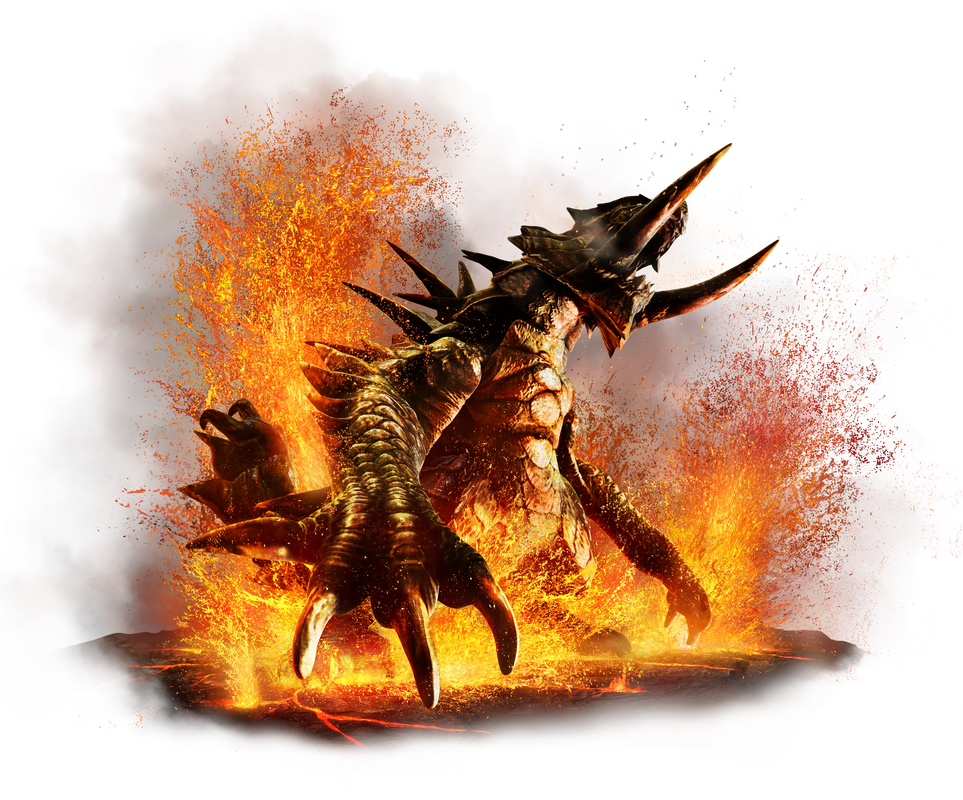
Akantor
Gargantuan wyvern (flying), unaligned
- Armor Class 18 (natural armor)
- Hit Points 245 (14d20 + 98)
- Speed 40 ft., burrow 30 ft.
STR DEX CON INT WIS CHA 27 (+8) 10 (+0) 25 (+7) 16 (+3) 15 (+2) 19 (+4)
- Saving Throws Dex +6, Con +13, Wis +8
- Skills Perception +8
- Damage Immunities fire; bludgeoning, piercing, slashing damage from nonmagical weapons
- Condition Immunities charmed, frightened, paralyzed
- Senses darkvision 120 ft., tremorsense 120 ft., passive Perception 18
- Languages -
- Challenge 20 (25,000 xp)
Magic Resistance. The akantor has advantage on saving throws against spells and other magical effects.
Legendary Resistance (3/Day). If the akantor fails a saving throw, it can choose to succeed instead.
Actions
Multiattack. The akantor makes three attacks, one with its bite, one with its claw and one with its tail.
Bite. Melee Weapon Attack: +14 to hit, reach 10 ft., one target. Hit 30 (4d10 + 8) piercing damage. If the target is a creature, it is grappled (escape DC 22) . Until this grapple ends, the target is restrained, and the akantor can't bite another target.
Claw. Melee Weapon Attack: +14 to hit, reach 15 ft., one target. Hit 14 (2d6 + 8) slashing damage.
Tail. Melee Weapon Attack: +14 to hit, reach 20 ft., one target. Hit 26 (4d8 + 8) bludgeoning damage.
Sonic Blast (Recharge 5-6). exhales a blast of air in a 120-foot line that is 10 feet wide. The blast destroys all terrain and structures, magic or otherwise, within its path. Each creature in that line must make a DC 21 Dexterity saving throw, taking 45 (13d6) force damage on a failed save, or half as much damage on a successful one.
Crush. If the akantor uses all of its movement to rise up on its hind legs. It can then use its action to slams its body in an area within 20 feet of its location that contains one or more other creatures. Each of those creatures must succeed on a DC 23 Strength or Dexterity saving throw (target's choice) or be knocked prone and take 22 (4d6 + 8) bludgeoning damage + 22 (4d6 + 8) fire damage. On a successful save, the creature takes only half the damage, isn't knocked prone, and is pushed 5 feet out of the akantor's space into an unoccupied space of the creature's choice. If no unoccupied space is with in range, the creature instead falls prone in the akantor's space.
Swallow. The akantor makes one bite attack against a Large or smaller creature it is grappling. If the attack hits, the target takes the bite damage, the target is swallowed, and the grapple ends. While swallowed, the creature is blinded and restrained, it has total cover against attacks and other effects outside the akantor, and it takes 21 (6d6) acid damage at the start of each of the akantor's turns.
If the akantor takes 50 damage or more on a single turn from a creature inside it, the akantor must succeed on a DC 22 Constitution saving throw at the end of that turn or regurgitate all swallowed creatures, which fall prone in a space within 10 feet of the akantor. If the akantor dies, a swallowed creature is no longer restrained by it and can escape from the corpse by using 30 feet of movement, exiting prone.Legendary Actions
The akantor can take 3 legendary actions, choosing from the options below. Only one legendary action option can be used at a time and only at the end of another creatures turn. The akantor regains spent legendary actions at the start of its turn.
Dig. The akantor burrows underground and move up to its burrow movement.
Detect. The akantor makes a Wisdom (Perception) Check.
Chomp (Costs 2 Actions). The akantor makes one bite attack or uses its Swallow.

Thank you
For
Checking this out
Thank you all for using this Monster hunter Monster Manual. I created a few monsters originally because I wanted to use them in my own campaign and progressed into this Monster Manual we have today.
This section is 18 pages of monsters from the series and I am pretty proud to say I created them. I hope you all enjoy using these creatures as much as I plan too and this is not the end.
The Monster Manual might be done, but thanks to a few ideas from users on Reddit. I plan on creating a compendium with loot tables for materials, all of the weapons from the videogame series, and rules for using these monsters in your own Monster Hunter D&D game.
If you are interested in letting me know what you think. Feel free to stop by my Twitch channel or check out my Patreon. Thank you for reading and I hope this book serves you well.
Art
Most art, except the cover art, has been gathered from https://monsterhunter.wikia.com website and edited if needed to fit the page. The few others are listed below.
Lore
Most Lore, about these monsters, was also gathered from https://monsterhunter.wikia.com and then edited to omit any mention of missing skills and make the lore more in line with a D&D setting.